Martinique – doesn’t the name bear elegance and classiness but also exotism? Indeed, the French Caribbean Island of Martinique delights its visitors with golden beaches, turquoise waters, lush greenery in abundance, tropical vibes, and French savoir-vivre.
Undoubtedly, Martinique is a feast for all your senses.
In this comprehensive guide, I’m telling you which ten places – or more precisely: areas – not to miss during your visit to Martinique and how to get there even if you are exploring the island comfortably by public bus.
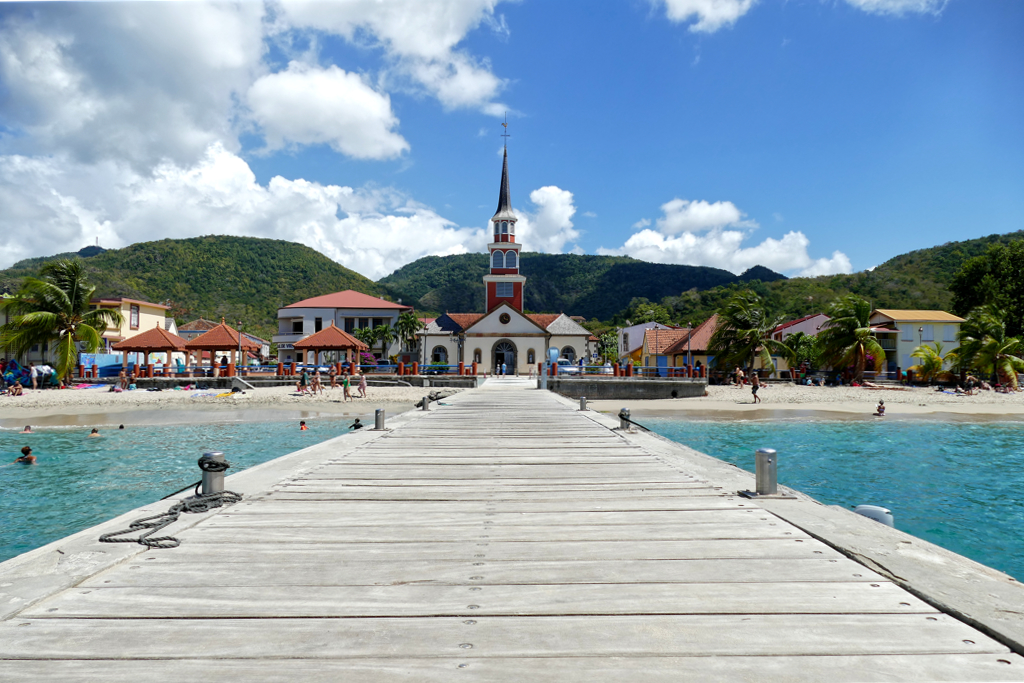
Martinique
The Caribbean island of Martinique is part of the Lesser Antilles and the Windward Islands. For historical and political reasons, Martinique is a so-called Département d’Outre-Mer, hence, a French overseas department. So are her big sister Goudeloupe and three other territories, by the way. This status makes the island politically a full part of France and therefore also of the European Union. Yet, the island is almost 7,000 kilometers away from Paris– not only geographically, but also mentally. Albeit, the official language is French, the inhabitants speak Creole. This local language derives from French, Indian, and African tongues.
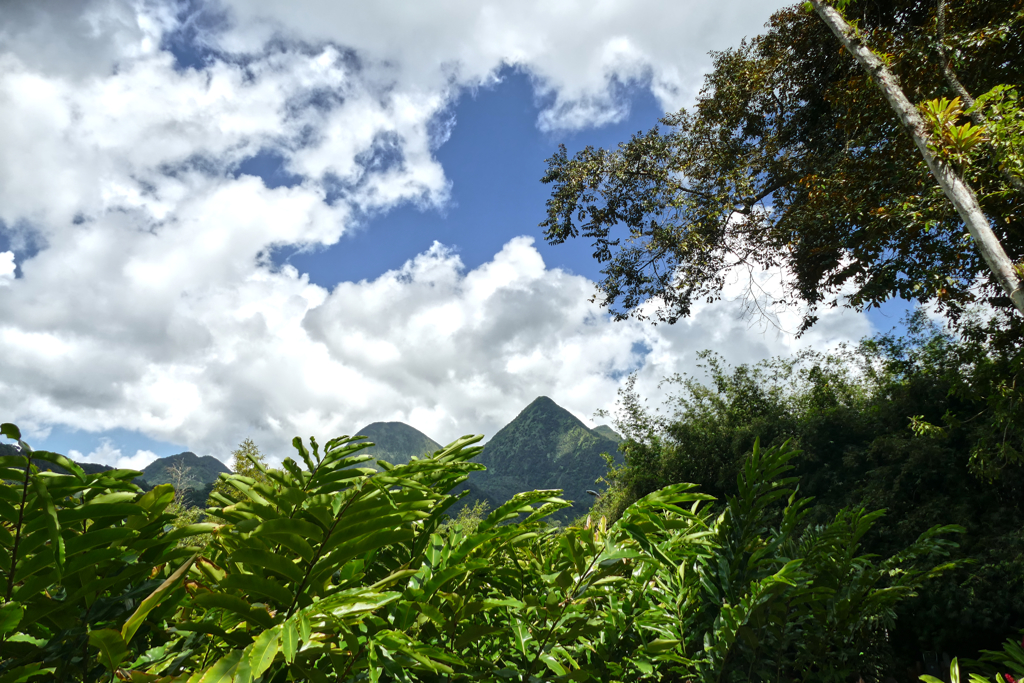
A 350-kilometer-long coastline is lining the mountainous island of Martinique. The Montagne Pelée volcano in the north has determined the fate of the island in the past as its eruption shifted political powers. Today, climbing up the almost 1,400-meter-high volcano is a popular activity among sporty ambitious holidaymakers.
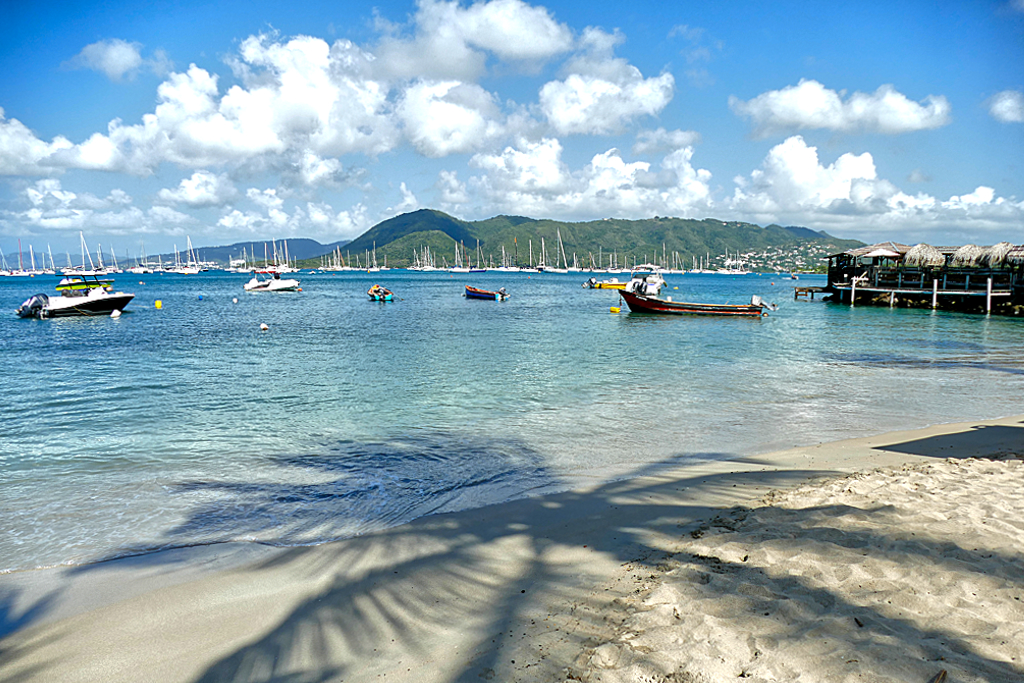
The varied landscape, the wild, lush mountainous terrain in the north, the long white, palm-lined sandy beaches along the turquoise water, and the traditional Creole culture make Martinique a small paradise in the heart of the Caribbean. Mind you, the aborigines called the island Madinina which translates to Flower Island. They were spot on: When you drive across the island and see the beguiling amount of colorful flowers in full bloom, you’ll immediately understand why.
A Little Bit Of History
While the island of Martinique is very pretty, its past isn’t. At all.
In 1635, Pierre Belain d’Esnambuc colonized the island on behalf of the Compagnie des îles d’Amérique founded by French Cardinal Richelieu. Caribs lived on the island, after whom the entire region is named to this day. However, the European invaders managed to wipe out almost the entire native population by 1660.
As on almost all other Caribbean islands, various European forces fought for hegemony in Martinique. Whether by the English, the Dutch, or the French – the fate of the colonies in the West Indies was decided in faraway Europe. And none of these nations were particularly soft-hearted.
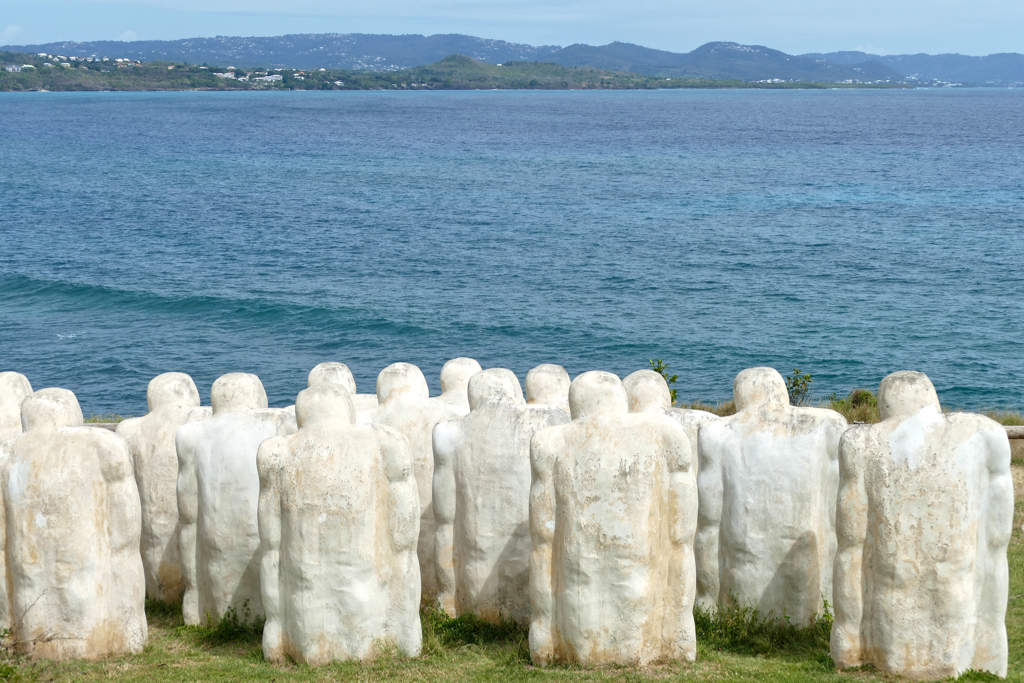
In 1685, the so-called Code Noir was passed, which confirmed and defined slavery in the French colonies. By 1783, approximately 60,000 slaves were forced to work mainly on the island’s sugarcane plantations. In the spirit of the French Revolution, the French Convention voted to abolish slavery in 1794. Sadly, these glory days did not last long as Napoléon reintroduced slavery in 1802. By the way, Joséphine, Napoléon’s wife, was born in the island’s part of Trois Îlets in 1794. It will come as no surprise that her parents owned a sugar cane plantation.
Free At Last?
Finally, in 1848, slavery was abolished. Yet, contrary to Guadeloupe where after the liberation, the slaveowners were beheaded on the Place de la Victoire, in Martinique these so-called Békés kept at least all the economic power. Not only were they generously compensated by the French government for the loss of their human property. They also viciously invented regulations that forced many of the former destitute slaves into a form of serfdom. Apparently, you can teach an old dog slavemaster new tricks.
To this date, the Békés rule the islands economically. Politically, however, France is in charge as Martinique became one of the country’s 101 Départments.
Don’t You Miss It: Ten Places to Visit
The island of Martinique is rightfully famous for its incredible number of beautiful beaches. Especially the southern part is basically hemmed with long stretches of white-golden sand. Palm trees are swaying in the light tropical breezes while the turquoise glittering sea washes crystal clear water in gentle waves onto the shore. On Martinique’s coast, you can spend your days in a picture postcard paradise.

On the other hand, there are tons of trails to be hiked, mountains to be climbed, historic places to be visited, towns to be explored, and rhum to be sampled.
Hence, it’s totally up to you whether you spend long days with sweet idleness or if you rise with the sun to explore the lush hinterland, stroll through charming small towns, go rhum tasting, or street art hunting.
As for me, I enjoy both. I want to experience everyday life, get to know the country and its people as much as I can, and get to know as many facets of this diverse island as possible.
But then it’s so hot and the spot in the shade under the palm tree seems to bear my name and I’ll suffer from heat stroke if I don’t jump into these clear waters straight away.
I want it all.
It’s in the Mix
I have therefore put together a list of places and activities that you should definitely do on the island. If you’ve been following my blog for a while, then you probably know that I don’t drive. Therefore, I visited all sorts of places around the world using public transport. Even places that are said to be impossible to travel to without a rental car.
This also applies to Martinique. Although it was said before my trip that I couldn’t get to know the island without my own car, I can say with certainty that this is not true. I did and saw everything I wanted to – and all with the help of public buses and ferries. And I hitchhiked twice despite my old age – which, by the way, is very common in Martinique.
The only thing that is unfortunately missing from my list are long hikes through the forests and up the mountains in the north of the island. Nonetheless, this is not due to the lack of public transportation. After my accident in Gran Canaria, I no longer go on unaccompanied hikes as a solo traveller.
Fort-de-France
Martinique’s capital Fort-de-France is located roughly in the middle of the west coast of the island. This makes it a good starting point for exploring both the north and the south – and of course the east coast – by public transport. However, there are some places that you can get to more quickly if you bypass Fort-de-France and change buses in Rivière-Salée instead, for example. I always point out the best and most direct options in this post. However, Fort-de-France is not just a major hub, but also quite charming and worth at least a half-day visit.
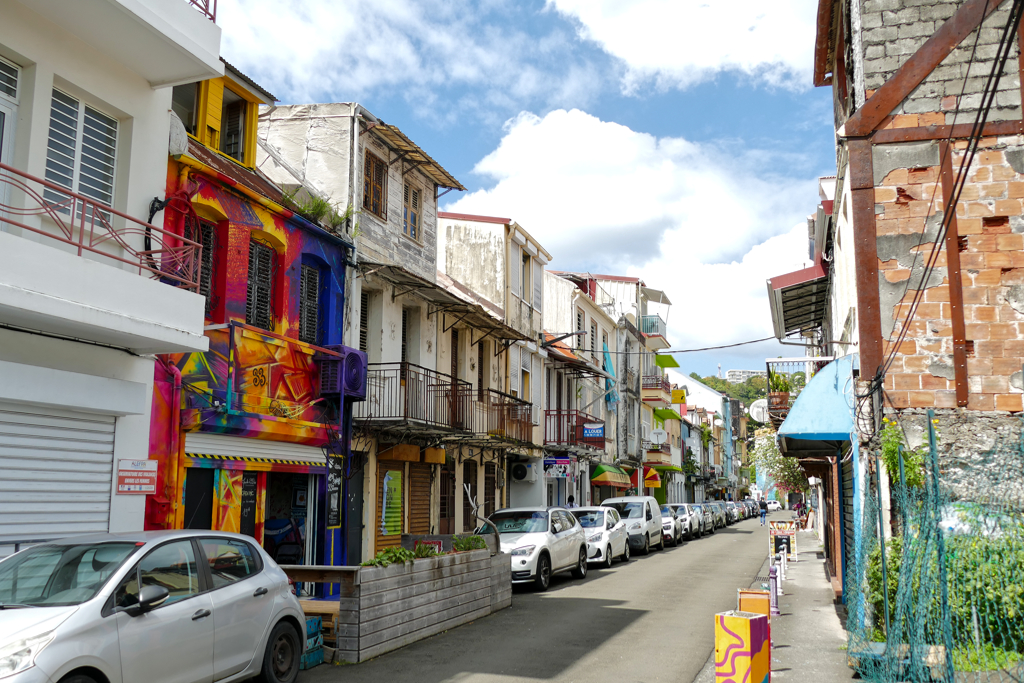
In the 19th century, the city of Saint Pierre was the island’s rather glamorous capital. Being called the Paris of the Caribbean, it was a cultural and economic hub. After a volcanic eruption almost completely destroyed the city in 1902, the seat of government was moved to Fort-de-France. The city then quickly became the economic and cultural center of the island. Today, Fort-de-France has about 75,000 inhabitants.
On the Waterfront
Whether you get to Fort-de-France by bus or by the Vedette Tropical, the small ferry crossing the Bay of Fort-de-France from the peninsula Les Trois Îlets, you’ll always arrive at the harborfront. From there, you can quickly make your way to the Cathédrale Saint-Louis which was built in 1895 under the lead of architect Pierre-Henry Picq.
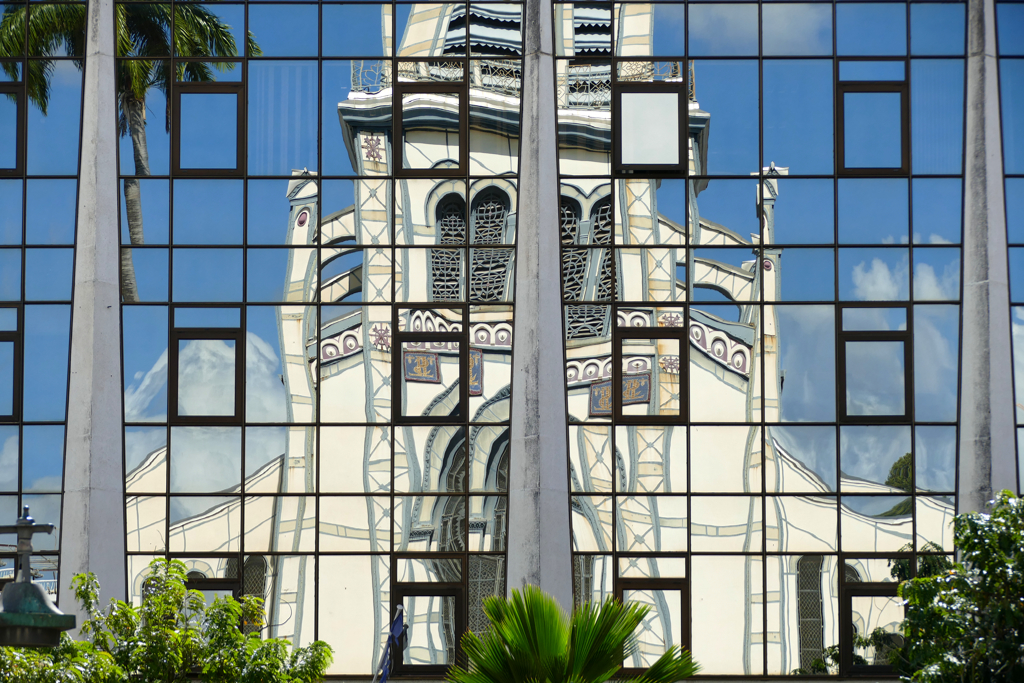
Picq was a French architect who came to Martinique in the 1890s and designed several buildings on the island. His work is clearly influenced by eclecticism, and he mostly created metal structures. Apart from the cathedral, he also created the city’s town hall, the iconic Bibliothèque Schœlcher, as well as the Grand Marché Couvert, hence, the covered market. Another of his works on the island is the Hôtel de Ville of the town of Le François.

By the way: A so-called Hôtel de Ville is not a city’s main guesthouse, it’s actually the town hall. As I explained in my post on the 10 Most Beautiful Palaces in the Marais Neighborhood of Paris, the French call different kinds of large stately buildings Hôtels – which also includes hotels.
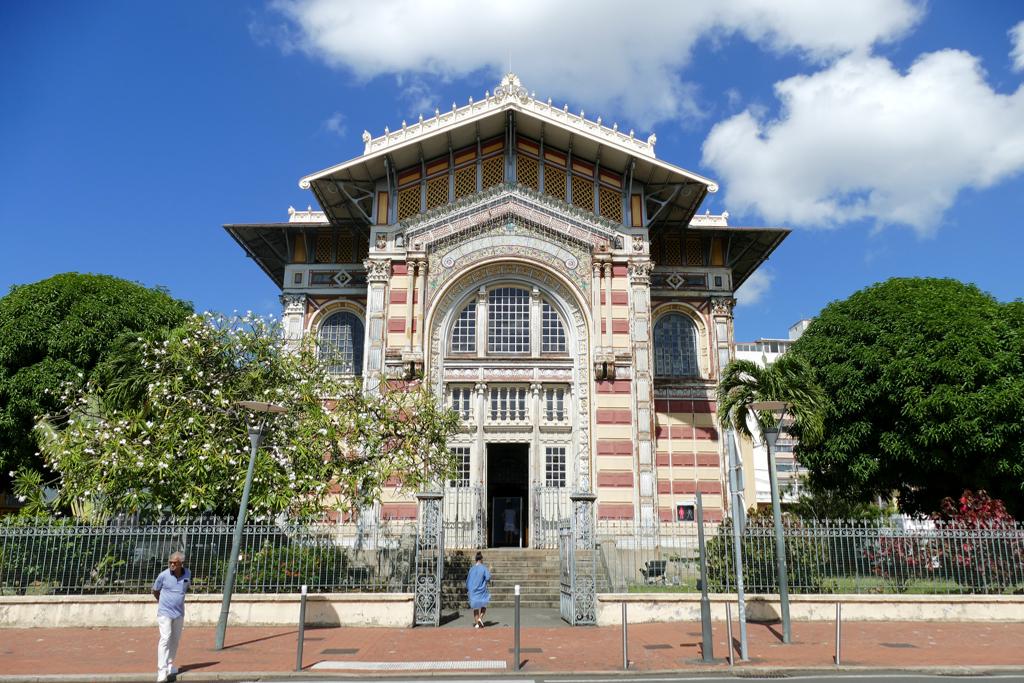
The Bibliothèque Schœlcher can be visited free of charge from Tuesday to Friday from 8 a.m. to 5.30 p.m., Saturdays until noon, and on Monday, they are opening only at 1 p.m.
Fun Fact:
The library, intended to store Schœlcher’s vast book collection, was completed in 1887 in the Jardin des Tuileries in Paris. It was eventually dismantled and shipped 7,000 kilometers to be re-erected in Fort-de-France. Various disasters such as a huge fire in 1890, which also destroyed most of the book collection, and a cyclone in 1891 caused that the library could not be re-opened until 1893.
Chapelle du Calvaire
Just above the city center stands this cute little chapel from the end of the 19th century. From here, you have an exceptional view of the city at your feet and all the way across the sea.

The easiest way to get up to the chapel is by taking one of the city buses #10, #14, #16, or #18 at the Nardal stop on Boulevard Général de Gaulle. Don’t get too comfortable as you have to get off at the very next stop.
Alternatively, you can follow the Trail of the Cross which the faithful walk on Christian holidays. To do so, turn into the Route de la Folie from Boulevard Général de Gaulle. Then, follow the path marked Calvaire and climb the 14 stations on foot.
Espace Camille Darsière
One highly interesting place that many visitors overlook is the Camille Darsières Cultural Center.

In this very spot used to be a courthouse that a fire completely destroyed in 1905. Architect Gustave de Laguarigue reconstructed the building in a neoclassical style in 1906. It was named after the great Martinican lawyer Camille Darsières.
After a new courthouse was built, the palace became a venue for culture. It is open to the public free of charge from Wednesday to Friday between noon and 6 p.m.
Yet Another Schœlcher
In the courtyard stood the inevitable statue of Victor Schœlcher. Schœlcher was a French politician and opponent of slavery in the French colonies. Today, streets’n’squares, schools, and even an entire town are named after Schœlcher, the white messiah. Honestly, they overdo it a little bit with good old Schœlcher. There is hardly a square or a park without his statue, no town without a boulevard bearing his name. Enough already, we got it, he was a do-gooder. But now let’s talk about the merits of the black leaders of slave revolts who actually risked their lives in the attempts to free their people. Or about people like Louis Delgrès, the black leader of the resistance to reoccupation and reinstitution of slavery by Napoleonic France, shall we?
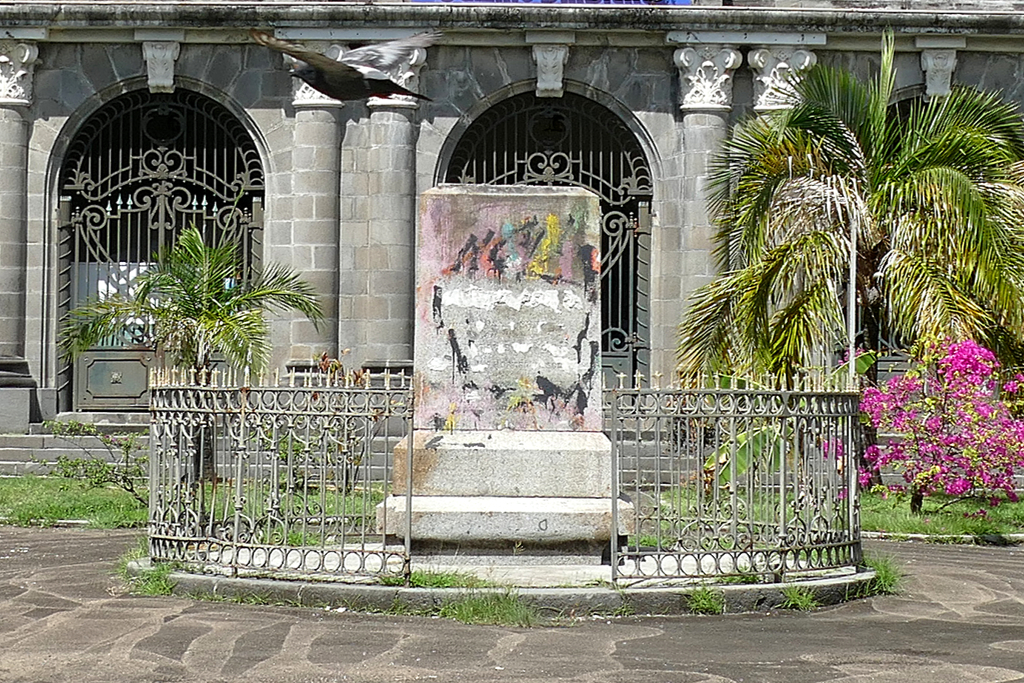
Actually, I do understand why locals see the cultish obsession with Victor Schœlcher with skepticism or even anger. After all, it insinuates that the brave white intellectual had to come to free the thick, obedient Africans from slavery. Also, many locals see Schœlcher as a token and alleged proof that not all white people were greedy racists. After all, as I pointed out above, the Békés still hold all the power in the former colonies. Hence, it’s understandable that locals want to knock the Békés’ alibi off its pedestal. And some actually do it: In 2020, protesters destroyed Schœlcher’s statue in the courtyard of the Espace Camille Darsière.
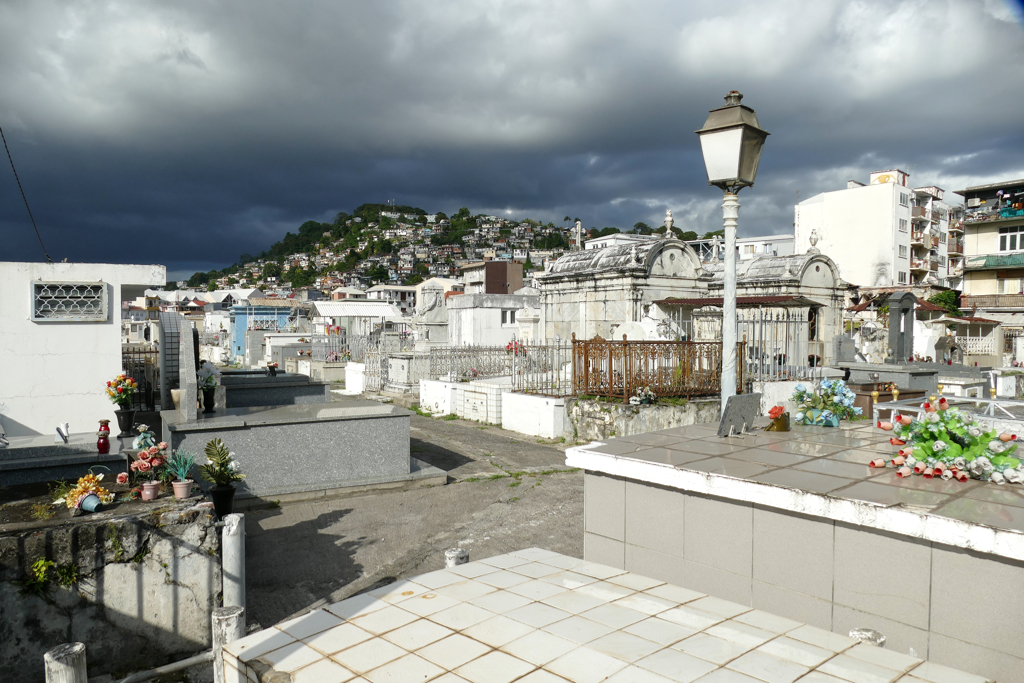
Fort Saint Louis
Just across the street is the lush Parc La Savane and south of the park is one of the most important historic landmarks, namely the Fort Saint-Louis. It was initially built to repel the attacks of Dutch troops in 1638. Today’s fort, however, is not only a listed historic site, but actually an operational naval base. Obviously, this part of the fort is left out on their guided tours.

Those tours take place from Tuesday to Friday on the full hour from 9 a.m. until noon and then again at 2 p.m. and at 3 p.m. Saturdays, they start on the full hour from 9 a.m. until 12 p.m. You can get your ticket for 8 €uros at the ticket office on Rue Victor Hugo 29 where the tours also begins.
My last tip for your visit to Fort-de-France: After a sweat-breaking visit to the Bastion, you can relax and take a refreshing dip on the beach La Française just below the citadel.
Urban Art
I would not argue that Fort-de-France – or any other city in Martinique, for that matter – is the true Mekka of street art. You’ll certainly find many more pieces in other metropolises around the globe – including Martinique’s big sister Guadeloupe, by the way. But since the agency Milmurs has organized and sponsored various editions of the Festival International d’Art Mural, they managed to put pieces by some really big names in the field of street art on their walls.

Below is a wild mix of backgrounds such as ethnicity and nationality. And always the word Humanity woven in between. At the bottom, there is everything desirable for the future, such as Respect, Education, and Courage.
Sadly, the hot’n’humid tropical climate causes the works of art to deteriorate much quicker than in other places. Hence, if you want to see the works shown here in all their glory, you should quickly make your way to Martinique.

Next to it is a fresh graffiti: Je suis la femme de ma vie, hence, I’m the woman of my life. Although the slogan is witty, it has a serious background as it thematizes violence against women.
Because street art is only a sub-aspect of a visit to Fort-de-France, I’ll stick with the first two easy-to-find works that are located in the shopping streets area.
Quartier Terres Sainville
Just like any other city around the globe, Fort-de-France has some less glorious neighborhoods. Those are located on the outskirts of the central shopping and administration district, obviously. One of them is Terres Sainville located north of the Cimetière la Levée. It’s not a bad neighborhood, it’s just an authentic residential area with lots of small businesses and many workshops. However, some of Terres Sainville’s walls were decorated with some truly outstanding pieces of urban art.
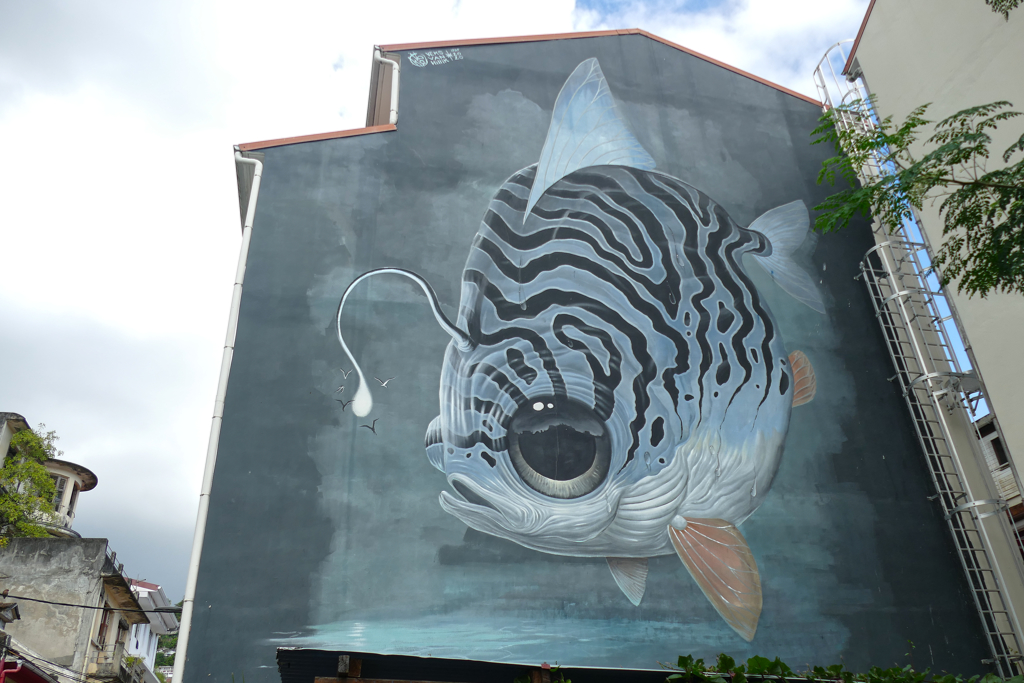
In my post The Best Street Art in Martinique, I introduce the most outstanding pieces and go into detail about their creators. You should definitely check it out.
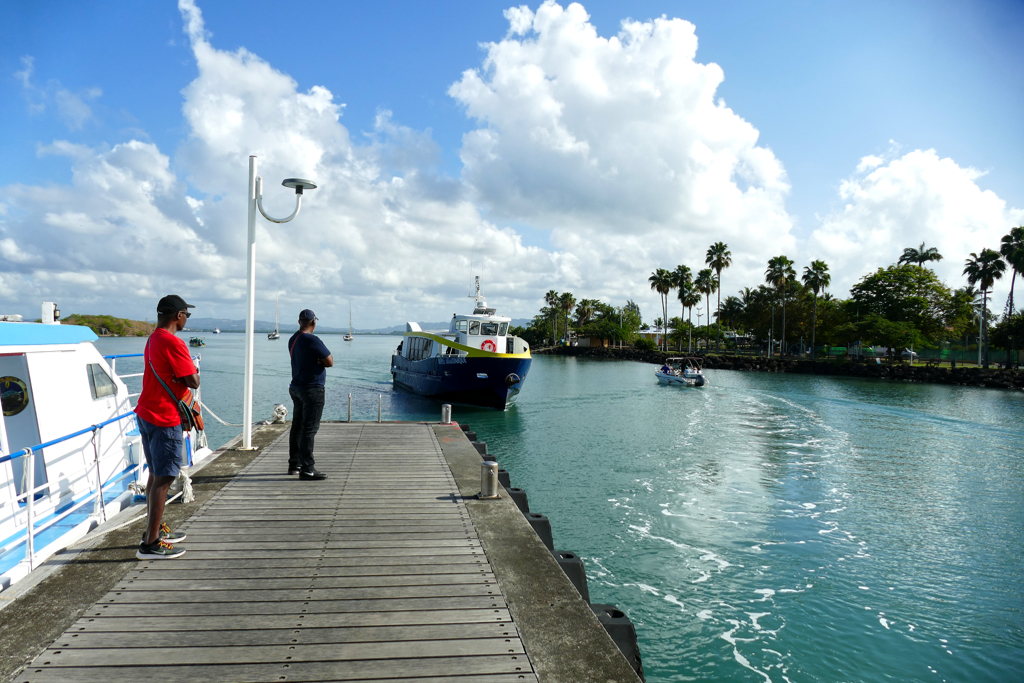
Saint Pierre
If you get up early and make it fast to Fort-de-France, if you don’t dawdle around, but instead pace to the places listed above, you can visit the capital in half a day. Then, you can hop on a bus and spend the other half in Saint Pierre.
Sounds too hectic for you?
You’re right, both cities are worth a full-day tour, especially since they both also have a city beach. This way, you can also go for a quick dip to cool down.
Pierre Belain d’Esnambuc founded Saint Pierre on behalf of Cardinal Richelieu in 1635. The city thrived due to the cultivation of sugarcane and the slave trade, obviously. It prospered into the economic and cultural center of the Lesser Antilles. At some point, it was even called Little Paris. Yes, annoyingly, people always feel the urge to call places the Paris of This or the Venice of That. Anyway, Saint Pierre was an important center of in parts questionable trade. Hence, it boasted a chamber of commerce, a theater, electric street lighting, and even a horse-drawn tram. Also, Saint Pierre had one of the first nursing homes for the mentally ill.
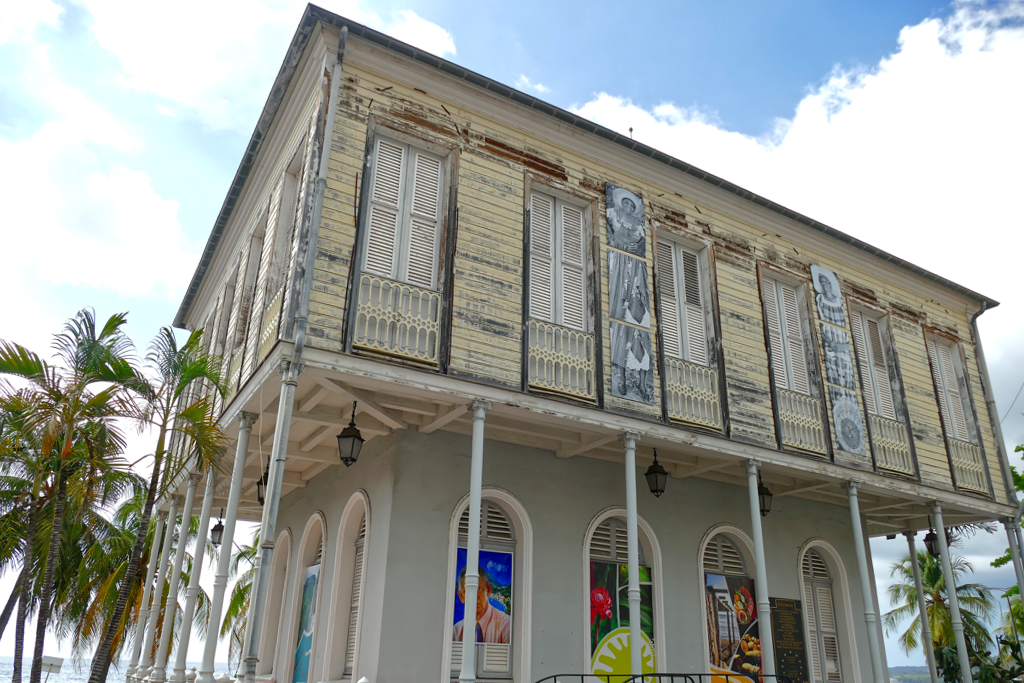
Then, in 1902, an eruption of the Mount Pelée volcano completely destroyed the city within minutes. All that remained was rubble and ashes. Of the 28,000 residents, only three survived.

You can learn more about the volcanological history and the catastrophe of 1902 at the Musée Franck A. Perret. Then, you can visit the ruins that remained of the theater and the fort church. The most interesting part, however, is the so-called Cachot de Cyparis.
Some Kind of Miracle
The Cyparis dungeon is a vaulted stone structure located at the bottom of a courtyard in the eastern part of the ruins of the former prison. Having injured his mate with a cutlass during a quarrel, Monsieur Louis-Auguste Cyparis was sentenced to a month of jail. This punishment actually saved his life as the sturdy walls of his dungeon sheltered him from the firestorm in 1902. Later, he became a questionable attraction at the American Barnum Circus where he exhibited his burned face and body to the audience. Eventually, the world forgot about him, and he passed impoverished in Panama.

Today, it is mainly the tragedy of 1902 that made Sainte Pierre one of the must-see places in Martinique. The Chamber of Commerce was reconstructed true to the original. Together with the Cathédrale Notre-Dame de l’Assomption, it is one of the major tourist attractions of the town, that today is home to a bit over 4,000 residents.
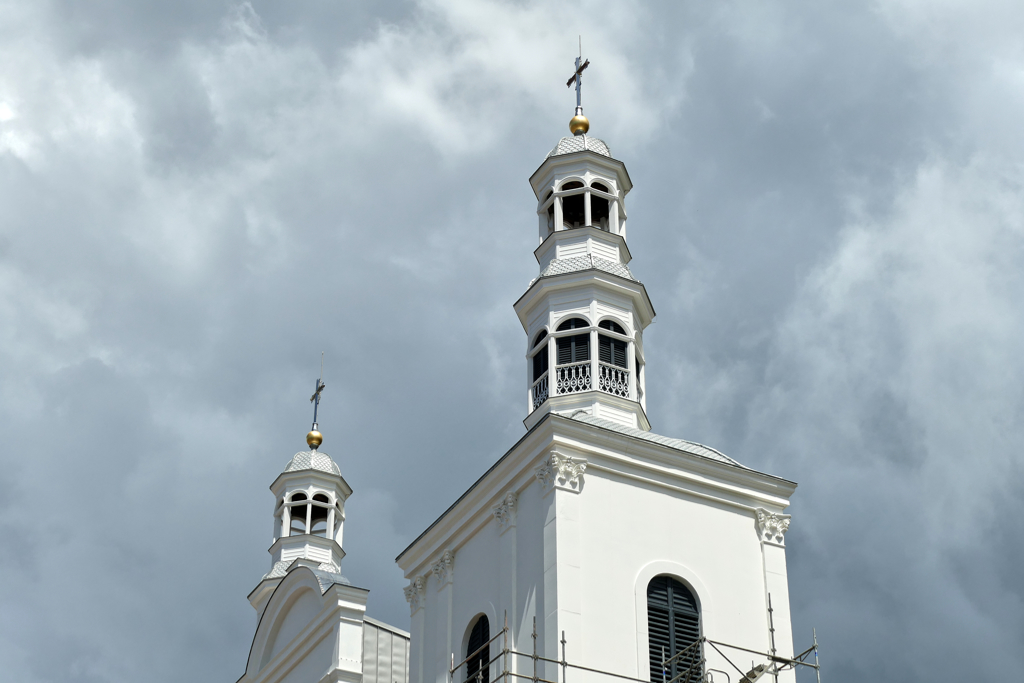
And also Mount Pelée became a major tourist spot that can be climbed. However, those who rather need a break after having explored the town in the tropical heat can relax on the city beach. It probably comes as no surprise that the coastline is covered by black lava sand.
What No One Is Talking About
While the loss of the former splendor that was gained through slave labor is mourned to this date, hardly anyone speaks of an earlier grievous event: The last indigenous people, the Caribs, committed suicide by throwing themselves from a high rock north of the city. They chose this tragic faith in order not to fall under the yoke of colonization or slavery. Today, the spot is known as the Tombeau des Caraïbes, hence, the Carib’s Tomb.
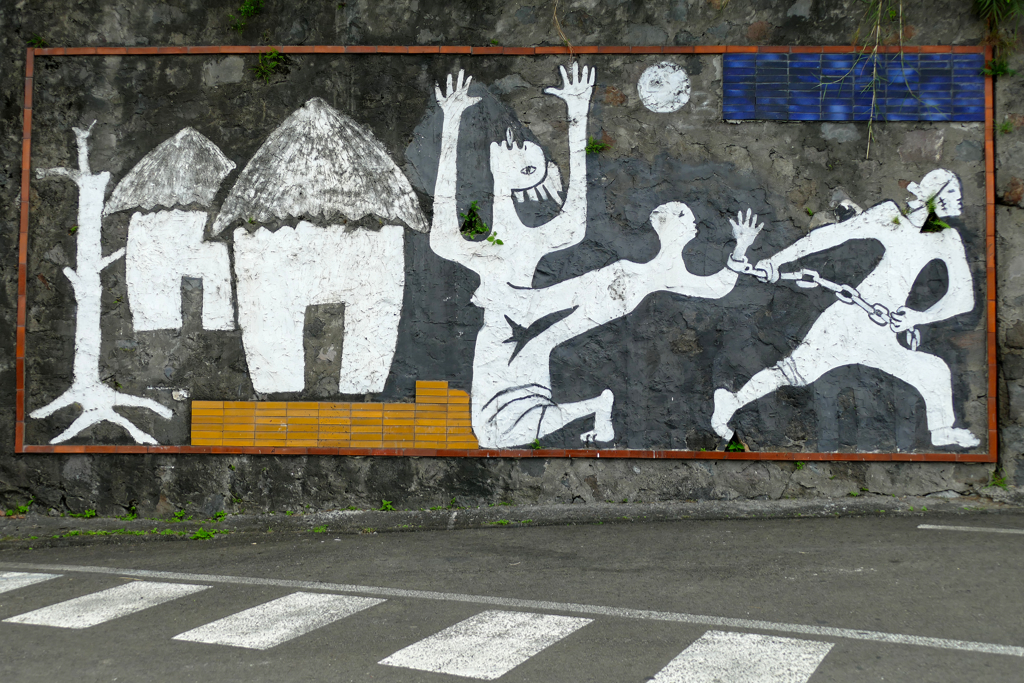
Also, since 2002, Saint Pierre has had an amazing piece of art that hardly anybody seems to notice. Local artist Hector Charpentier has created a fresco that covers over 200 meters of a wall on the eastern side of Rue Abbé Grégoire.
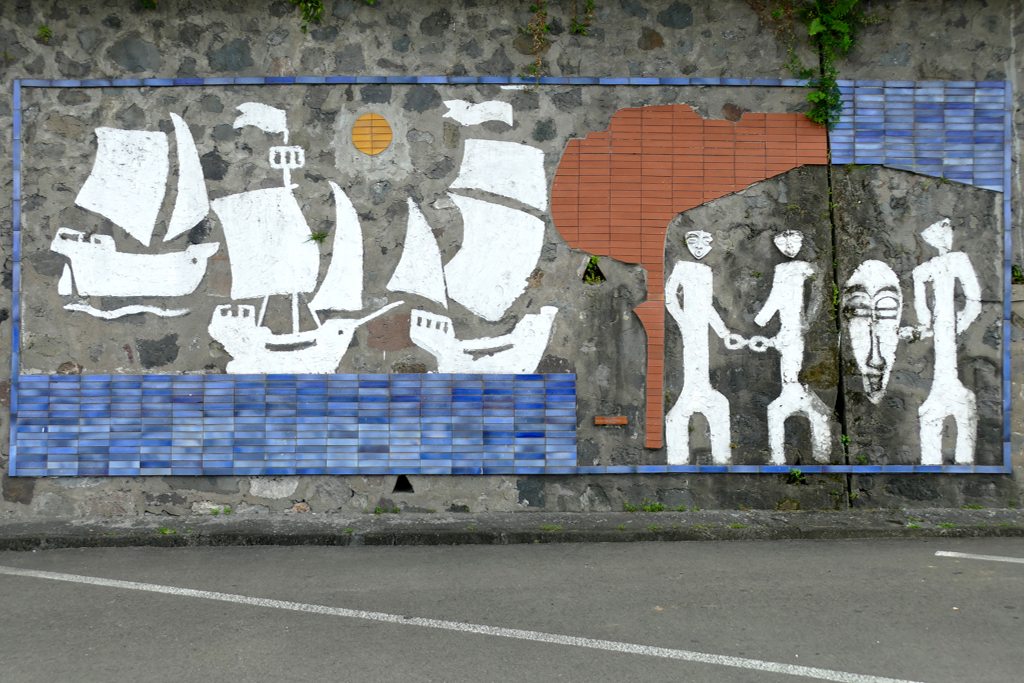
In seven expressive images, it depicts the history of the Atlantic slave trade until its abolition.
Jardin de Balata
I used to think it was completely stupid to set up a botanical garden in a region as lush as the Caribbean. Isn’t the whole island one big botanical garden of Eden? And although this perspective is not false, I have now visited a number of botanical gardens in tropical climates which made me reconsider. I definitely see a sense in a landscaped botanical garden. Apart from research and preserving biodiversity, walking between carefully and harmoniously laid out beds and enclosures is simply beautiful.
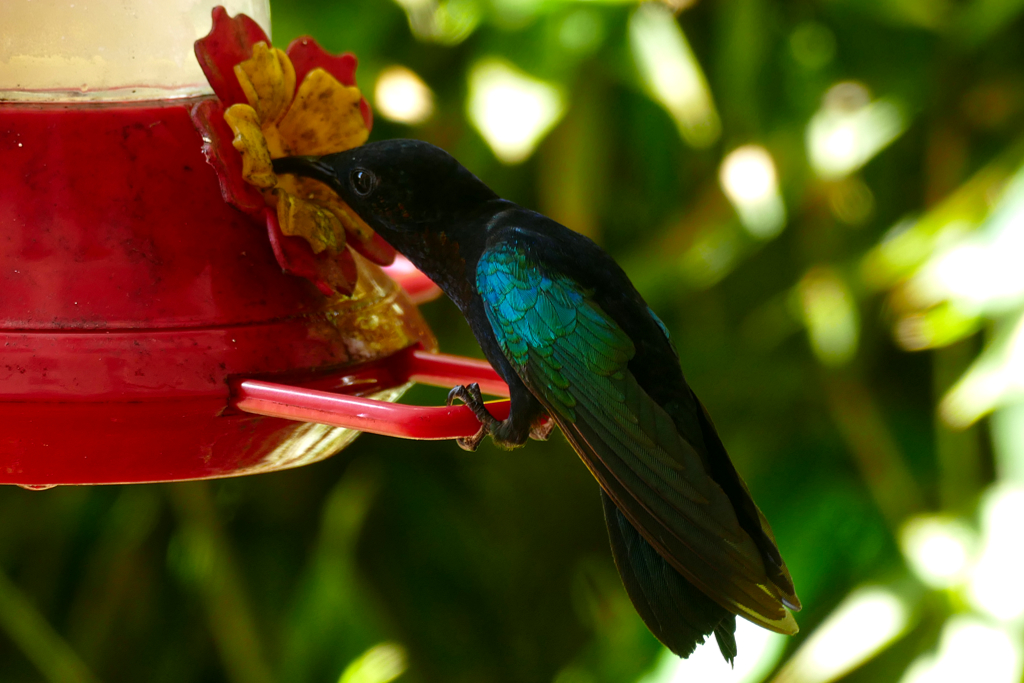
Today I see botanical gardens as a collaborative work of art between nature and passionate botanists. Practically a work of art made from plants.
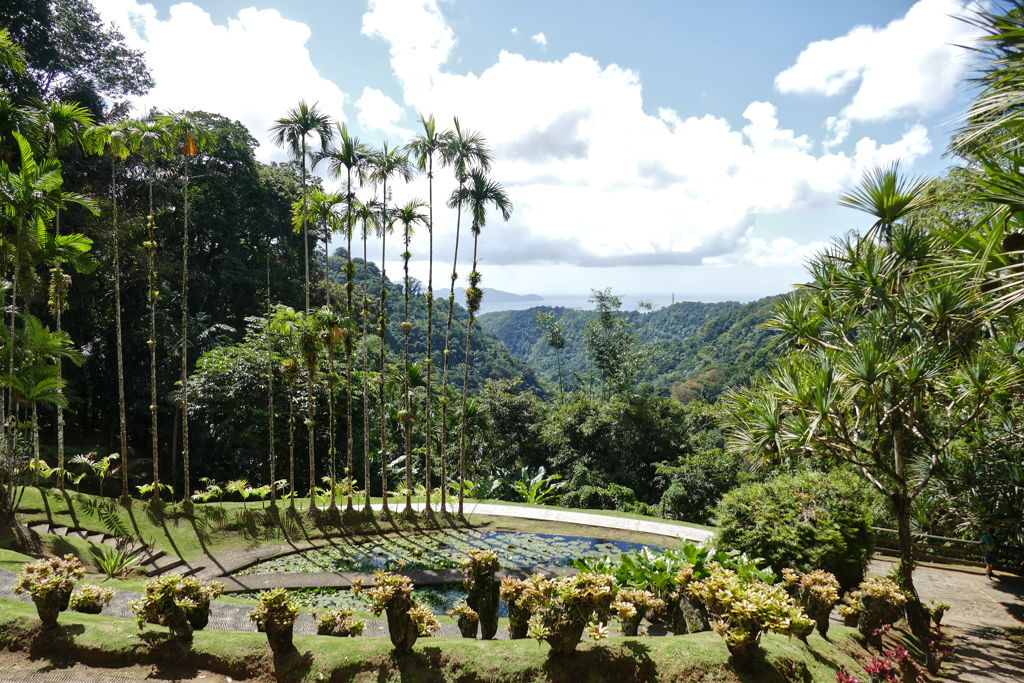
Horticulturist Jean-Philippe Thoze designed the Jardin de Balata. Although he opened the park in 1986, the final touches and details still took him another 20 years. With the name Balata, Thoze honors the balata tree, an endangered species that you’ll still find mainly in Central America and the Caribbean.
Nature in Perfection
The botanical garden gives around 3,000 different species of tropical plants from all over the world a loving home. Mind you, there are an incredible 80 kinds of palm trees alone!
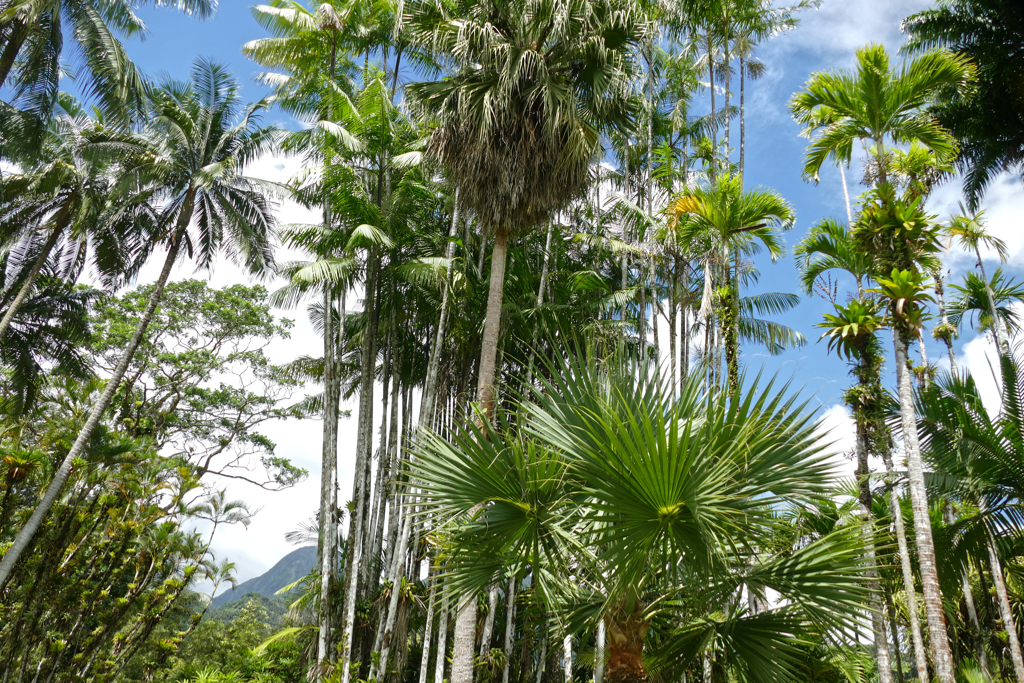
On an area of approximately 3 hectares are growing tropical decorative trees, bromeliads and orchids, hibiscus and water lilies, herbaceous plants, ferns, bamboo, and medical plants.

The terrain is hilly and some parts can only be reached via steep paths and stairs. The facility consists of wild parts and manicured enclosures. The arrangements around the three bodies of water, hence, the palm pond, the fish pond, and the Japanese pond, are particularly alluring.
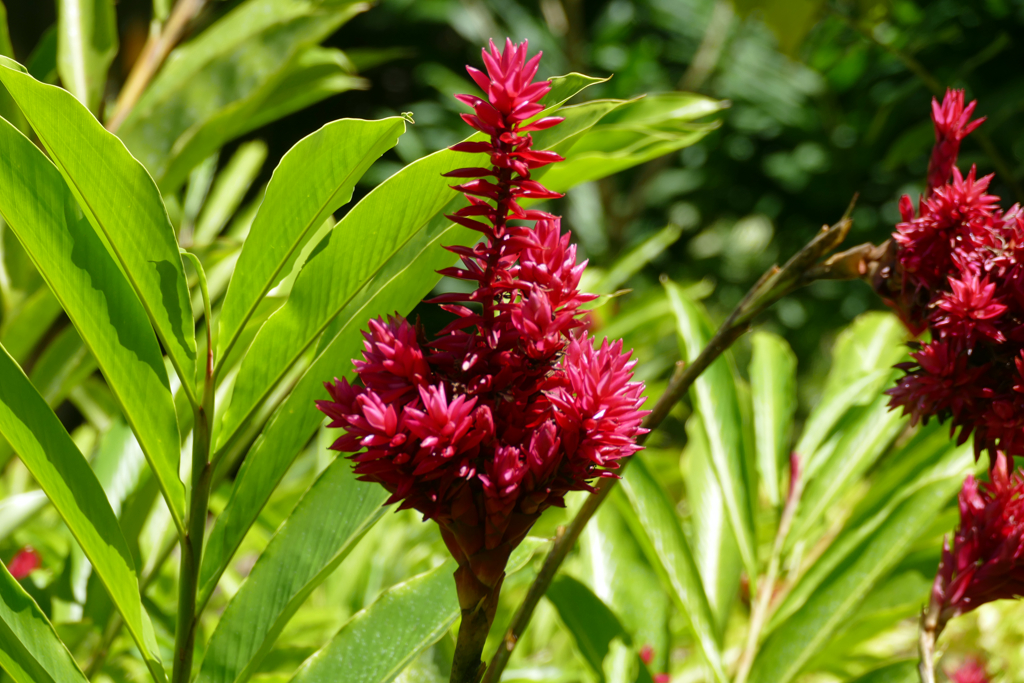
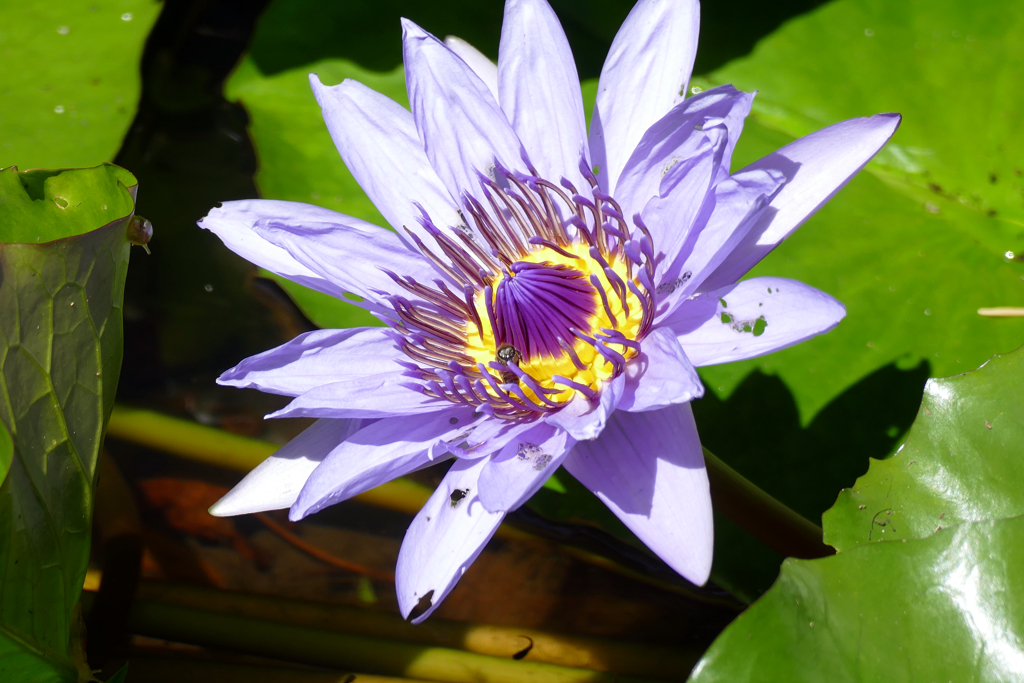
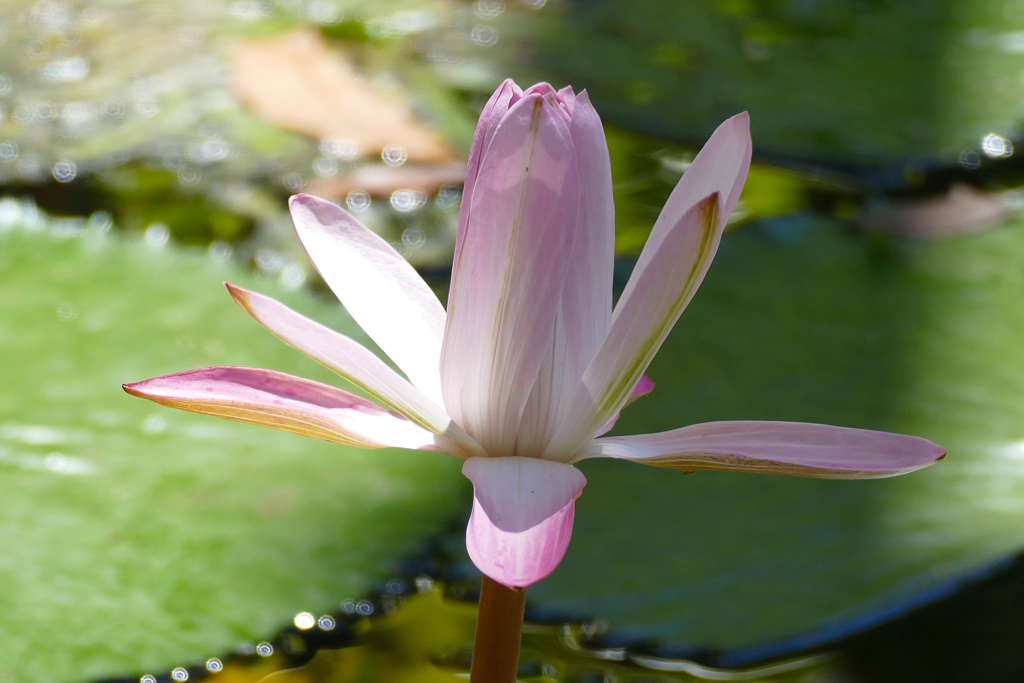

The tour on the paths is very well signposted. In between there are enough small pavilions and benches to relax and take in the wonderful surroundings.

An absolute highlight of the visit is a canopy walk in the highest treetops.
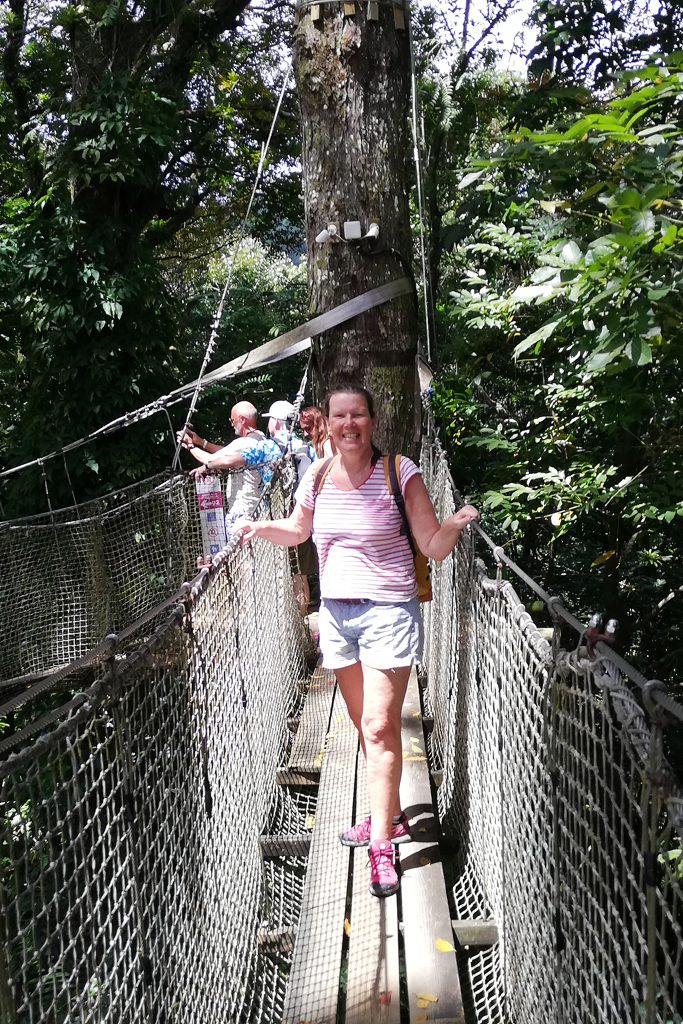
Depending on the number of visitors, however, you may have to expect a waiting time of up to 15 minutes. For safety reasons, only a certain number of people are allowed to be on the planks and the bridgeheads at the same time. However, walking on the shaky panels secured with steel cables is definitely worth the wait.
After an inspiring visit, a break at their restaurant and checking out their large gift shop will make your visit complete.
Jardin de Balata is open every day from 9 a.m. to 6 p.m. for a general entrance fee of 16 €uros.
Le François And Habitation Clément
Another not-to-miss day tour took me to Martinique’s east coast. There, the town of Le François is surrounded by endless sugar cane fields and banana plantations. Actually, as a city, Le François is not that great. Apart from the town hall designed by Pierre-Henry Picq whom I introduced above, there is not much that is inspiring for the foreign guest to discover.

As a matter of fact, Le François rather scores as a gateway. Explore the ecologically precious mangroves on a rowing tour or follow a local tradition and take a boat to the sandy shallows or islets at the Fonds Blancs or La Baignoire de Joséphine in the bay off the coast. There you can then enjoy a glass of local punch standing in the shallow waters.
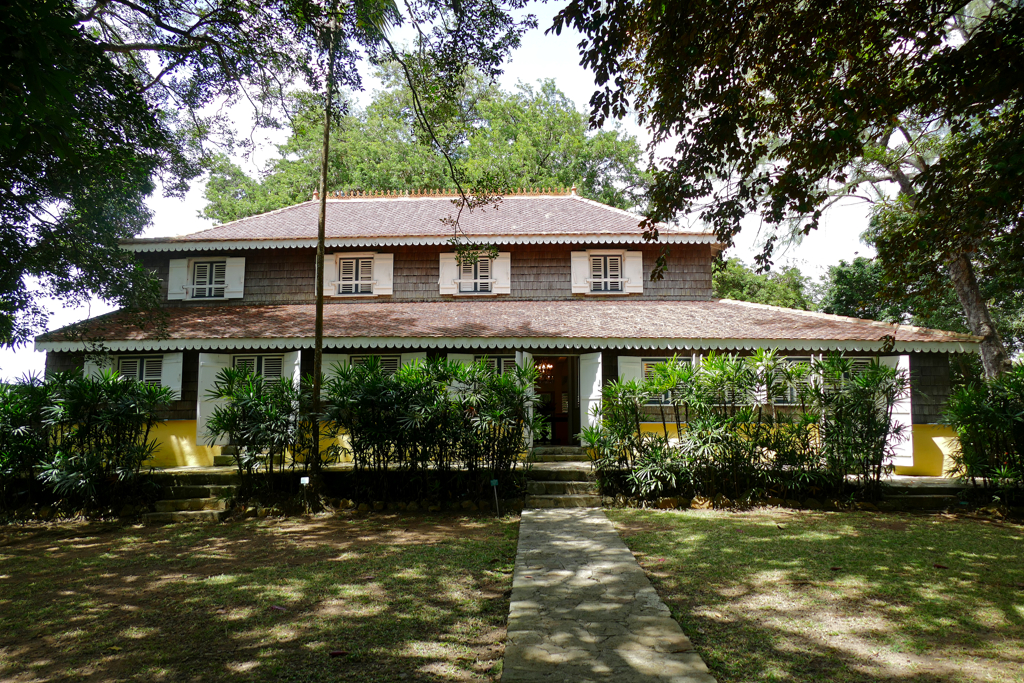
As we are on the subject of booze: Located a little to the southwest of the town is Habitation Clément.
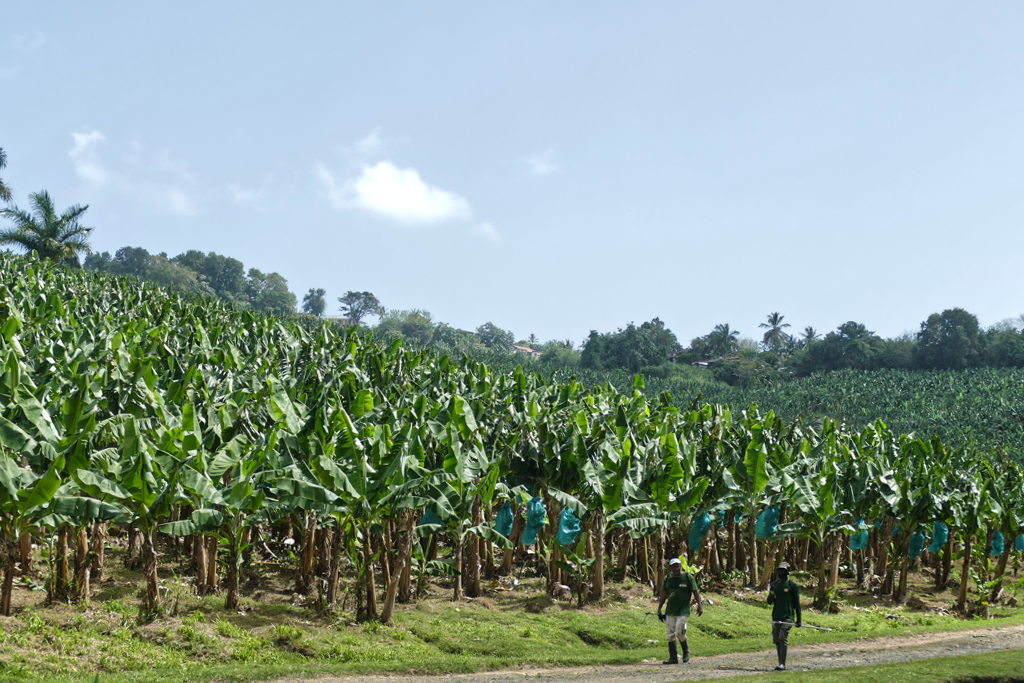
A Habitation is an estate that consists of plantations, a posh colonial master’s mansion, and in the past also of humble slave quarters.
The Good Doctor
Until Homère Clément, a politician and one of the very first colored doctors in Martinique, acquired the plantation, it was called Habitation de l’Acajou. Clément transformed it into a distillery in 1887.
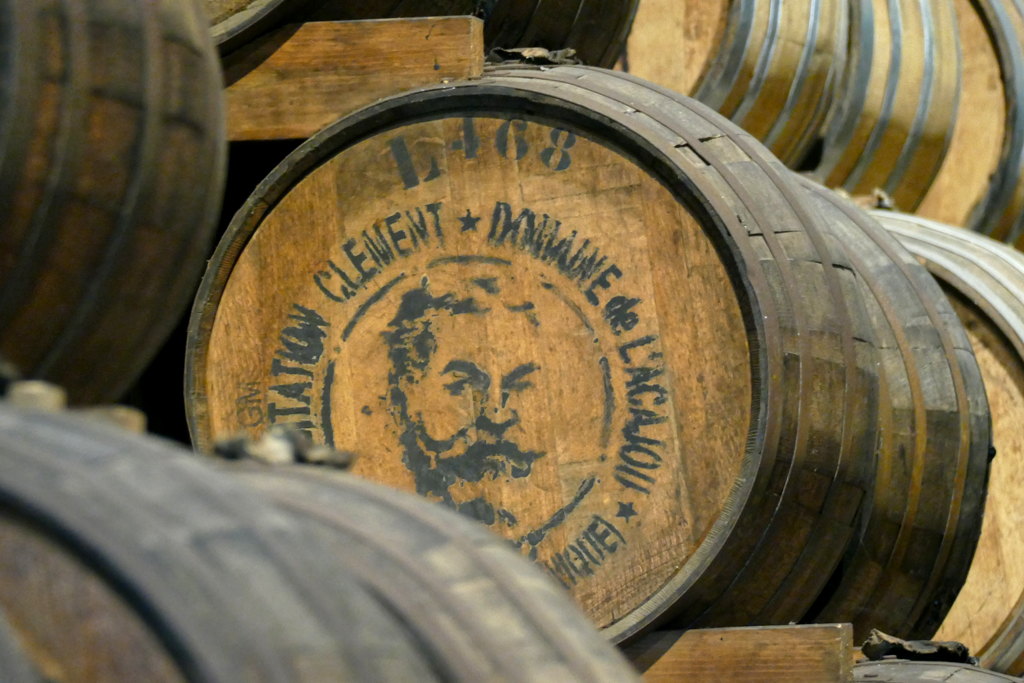
Many decades later, it was purchased by Bernard Hayot, a so-called Béké. As a matter of fact, from the Carrefour supermarkets to the rental car companies: This filthy rich heir owns basically all significant businesses on the island of Martinique.
Nevertheless, Hayot transformed the Habitation into an information center on Rhum production. Although today, distillation is outsourced to an industrial site, the product is still aging in various cellars on the premises.
Pictures at an Exhibition
However, the heart of Habitation Clément are the amazing sculptures scattered around the spacious, lush gardens. The installations are truly impressive, and they strongly reminded me of the wonderful Inhotim Botanic Garden and Gallery I visited a couple of years ago during my trip to Brazil.

Severino was born in the Dominican Republic, hence, she’s one of the Caribbean artists on display.
Of course, the Habitation claims that its mission is to promote Caribbean art. That’s commendable, yet, there are not that many works by Caribbean artists. You’ll see pieces by Ugo Rondinone, Dale Chihuly, and Daniel Buren. But yes, also by Hervé Beuze, who actually is from Martinique.

They also have a Pinakothek where currently, a temporary exhibition of contemporary art from Benin is on display. Those works are absolutely outstanding and made me look forward to the upcoming art biennial in Venice.

This piece is part of the amazing temporary exhibition of art from Benin.
After strolling through the sculpture garden, admiring the splendor of the old mansion, and seeing how the precious liquid is produced, you can treat yourself to shots of various high-class Rhums in the taproom. Then, of course, you can purchase these fine products for later or as a special souvenir at their vast gift shop.
Although Habitation Clément stands for many things that make you grind your teeth – colonialism, slavery, exploitation, social injustice, and ignorance – aesthetically it is a very pleasing facility and definitely worth a visit.
Habitation Clément is open every day from 9 a.m. to 6.30 p.m. The general entrance fee is 13 €uros, but you pay only 11 €uros if you buy your ticket online on their website.
Les Trois Îlets
A church house, gin house
A school house, outhouse
On highway number nineteen
The people keep the city clean
They call it…
…well, in this case, they call it Les Trois Îlets. Yes, Ike and Tina Turner’s biggest hit Notbush City Limits could be about so many small towns – and also about the main town of the peninsula on the southern end of the bay of Fort-de-France. Jesuits founded the city in 1683. No wonder this one-horse town was initially called Le cul de sac à vaches, hence, the cul de sac of cows. In 1849, it was renamed to Les Trois Îlets, hence, three islets, referring to the three small isles Sixtain, Charles, and Thébloux that lay off the shore.
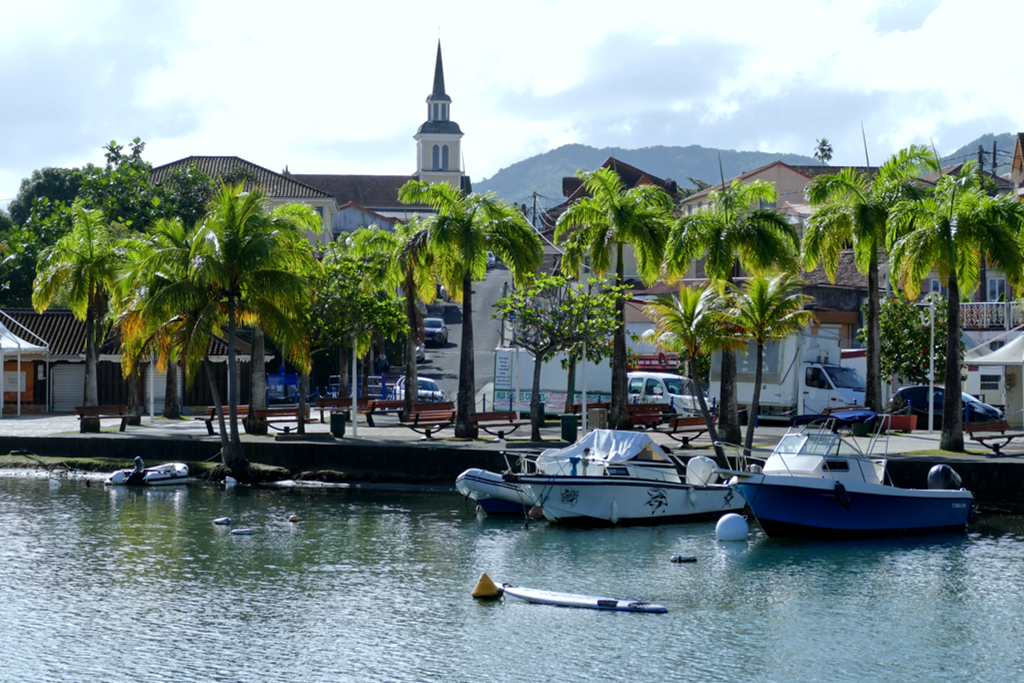
Although the town itself is nothing to write home about, several scenic and historically valuable sites in the nearby area are worth visiting.
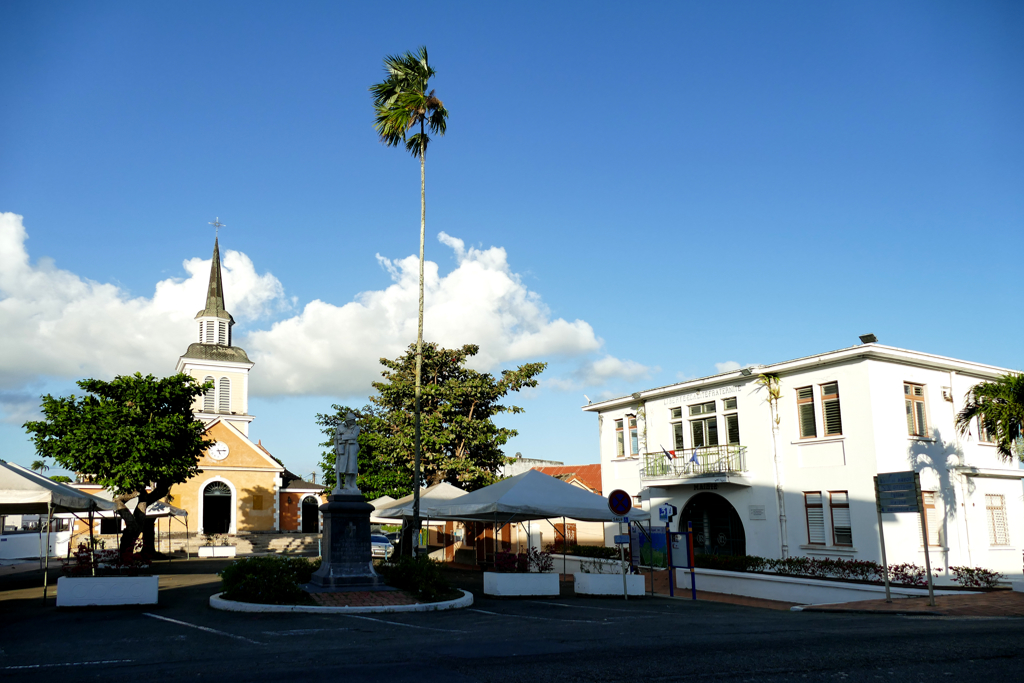
Yes, Ike and Tina are absolutely right, it starts with the church house. Notre-Dame de la Bonne-Délivrance was built in 1724 and stands on the main square next to the old town hall. In this very church, the naval officer Joseph-Gaspard de Taschener married Rose-Claire des Verges de Sannois in 1761. Three years later, their offspring Marie Josephe Rose de Taschener de la Pagerie was baptized in the church.
Joséphine
Now, if you wonder why I’m telling you about these good people, the name Joséphine might sound familiar. And it might ring an even larger bell when I tell you that this young lady married a certain General Napoléon Bonaparte in 1796. Her famous husband took it upon him to personally crown her Empress of France in the Notre Dame Cathedral in Paris in 1804.
Joséphine’s family owned the plantation La Pagerie consisting of over 1,200 hectares of mostly sugar cane and cocoa. They also owned around 300 slaves. This had certainly an important impact on the progress of French colonialism. After all, it was Joséphine’s hubby Napoléon who reintroduced slavery which had been abolished after the French Revolution in 1802.
As a hurricane destroyed the plantation’s main building in 1766, only the stone kitchen house has been preserved. Today, it houses the Musée de La Pagerie. It is open from Tuesday to Sunday between 9 a.m. and 4 p.m. and can be visited for an entrance fee of 5 €uros.
However, since Joséphine hasn’t exactly covered herself with glory, in my opinion, there are more important places in Martinique that one should visit.
La Savane Des Esclaves
For instance, just two kilometers southeast of the Pagerie is the museum village La Savane Des Esclaves. Scattered on a 2-hectare greenery is the village of Antan Lontan. It consists of small ancient dwellings built from simple wood. They have raw clay floors and roofs made of reeds. Here you can experience what life was like for the so-called neg mawon, the slaves that escaped their bondage, back in the early 19th century. Consequently, one of the huts is dedicated to the rememberings of their ancestors where life-size sculptures illustrate everyday scenarios.
Touring the village, you’ll also learn about traditional crafts like waving, woodcarving, and the production of various edibles.
La Savane Des Esclaves is open from Monday to Saturday between 9 a.m. and 4.30 p.m., on Sundays, they are already closing at 11.30 a.m. The general entrance fee is 12 €uros.
There’s More
As you make your way between the beautiful colonial houses of the center of Les Trois Îlets, you will come to a small port. Fishing boats as well as tourist excursion boats leave from here. And here you can also take the ferry Vadette Tropicale to Fort-de-France. This saves you at least an hour and a lot of hassle compared to the bus journey. There are two ticket machines right next to the jetty. You can select the language and then either buy a one-way ticket for 5 €uros or a return ticket for 7 €uros. If you plan to take the Vedette more often, you might want to opt for a season ticket for twelve trips. This pass costs 36 €uros.
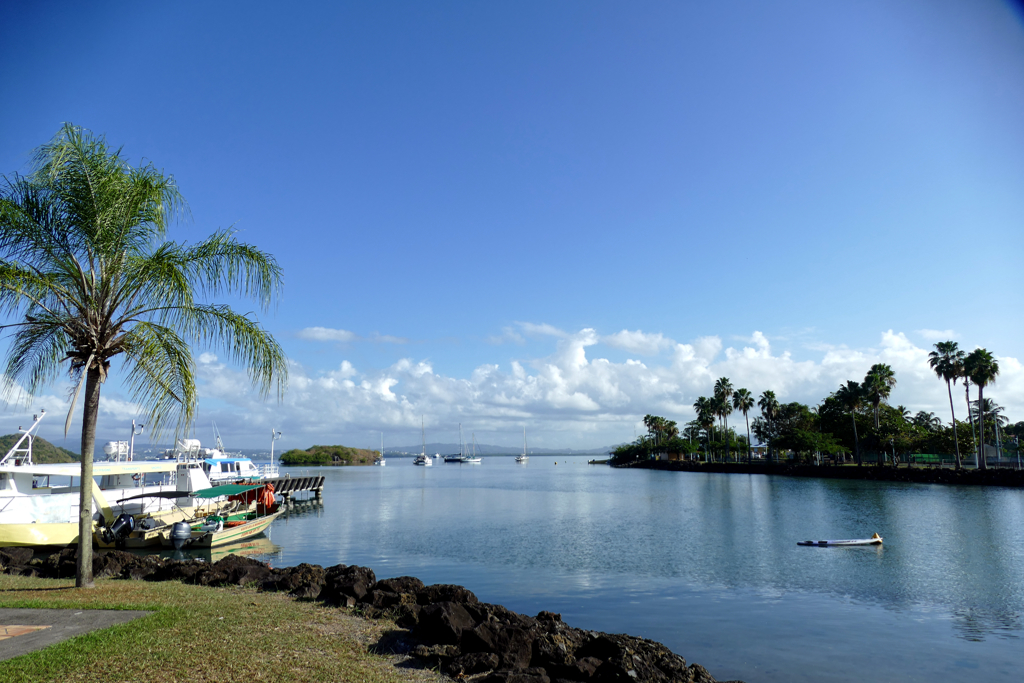
If you just want to take a short trip, you can get off the ferry at the next stop, Pointe du Bout. There you find yourself in probably the most touristy developed part of Martinique. Here are many hotels, a golf course, a marina, a casino, and the beach of Anse Mitan.
Plantation Vatable
A short walk from Les Trois Îlets eastwards takes you to the Forêt de Vatable. Don’t forget to enjoy the amazing views of Fort-de-France, Bay Genipa, as well as the three name-giving islands.
After about fifteen minutes, you reach the Habitation Vatable, one of the oldest plantations in the area. The Vatable family owned the property from 1820 to 1904. Then Justin Mario bought the site and established a new distillery on the premises. He produced the rum brand Le Soleil until 1962.
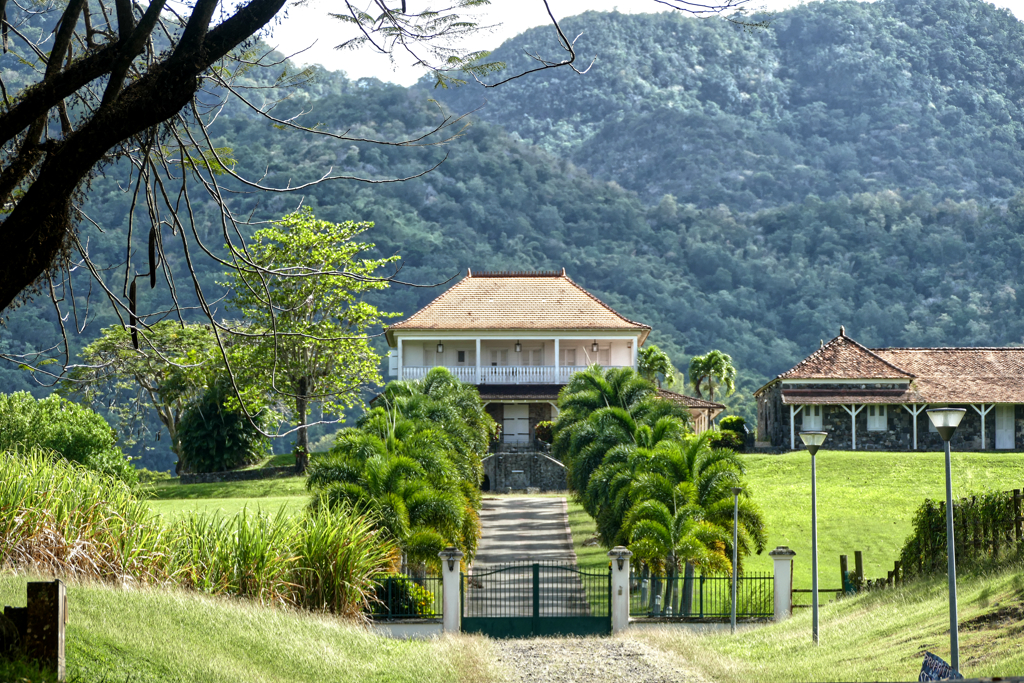
The magnificent mansion is closed to the public. Although it would certainly attract many travellers who are into lost places. After all, a gruesome crime happened here that remains unsolved to this date. In 1968, the terribly mutilated bodies of the owner Luc Mario, and his personal assistant Clairville Thésée were found in the manor in 1968. This murder is one of the most mysterious crimes that Martinique has ever experienced.
I can imagine that a special breed of tourists would love to visit this scary crime scene, yet, this part of Habitation Vatable is not open to the public.
Forêt de Vatable
Nevertheless, other parts of the former estate are: Just across the road is the entrance to the Vatable forest, a popular recreational area visited more by locals than tourists. However, make sure to wear sturdy hiking boots or at least trainers as you visit this wet’n’wild forest. The trails are not necessarily even, and many huge roots are sticking out from the ground. Also, don’t forget that mangroves equal wetlands, hence, you might encounter puddles and mud, especially after rain showers. Talking ’bout mangroves: To explore these wonder plants that are basically protecting the entire coast in this area, you can rent a kayak. For a great alternative to learn more about the ecosystem, you better join a guided boat tour through the mangroves. Tour operators are located at the port of Les Trois Îlets.
Maison de la Canne
As I mentioned above, the Vatable distillery produced rum until 1962. On the site where the slave quarters used to be is today a museum. This so-called Maison de la Canne, the House of Sugar Cane, pays tribute to the sugar processing industry and those forced to work there.
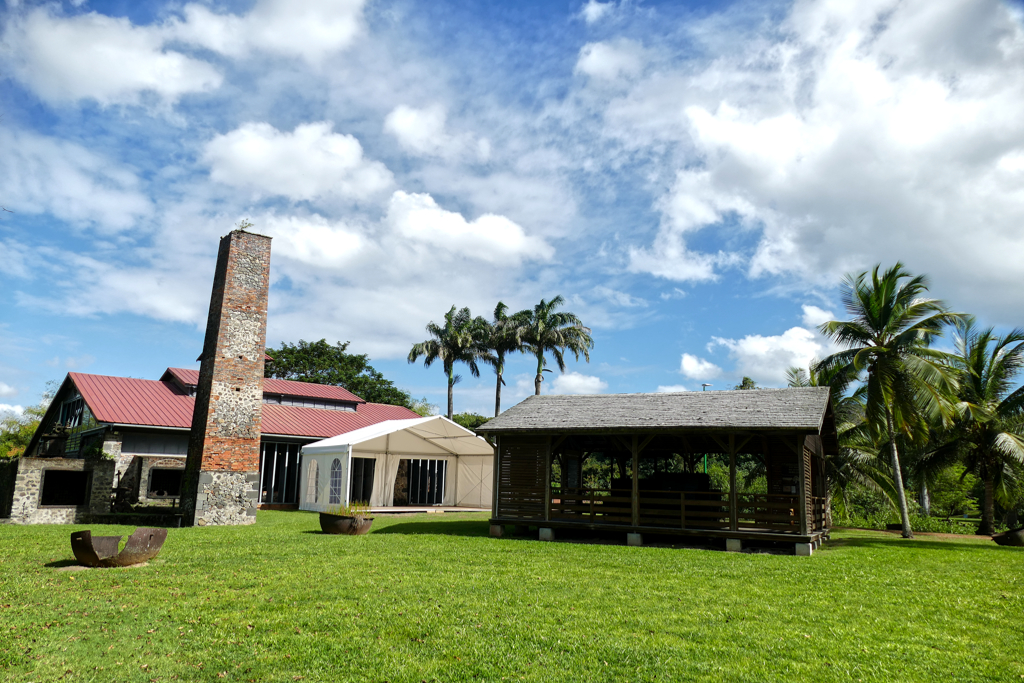
An informative and very touching exhibition traces the history of sugar cane since its introduction to Martinique in the 17th century. It shows photographs, documents, and models. On display is also the heavy machinery they used to crush the stakes as well as an old locomotive that was used to transport the cane from the fields to the distillery.
The Maison de la Canne is open Tuesday to Friday from 8 a.m. to 5.30 p.m. On Saturdays, they are open only at 8.30 a.m. and on Sundays at 9 a.m. Also, on weekends, there is a lunch break between 1 p.m. and 2 p.m. which makes me question why they are skipping lunch the other days. Howsoever, there is an entrance fee of as little as 4 €uros.
Village de la Poterie
Finally, here’s a tip for your souvenir shopping: About two kilometers and a twenty-minute walk east is the so-called Village de la poterie. This pottery village has existed since 1783, making it one of the oldest sites in Martinique. It is located on the grounds of a former Jesuit monastery from the 17th century. Since the middle of the 18th century, the village has been dedicated to clay processing. Over the years, finer pottery crafts were added to the production of bricks’n’tiles.
Today the authentic Creole houses house craftsmen, artisans, and, of course, shops. Let the fine ceramics, paintings, woodcarving, and jewelry in the approximately 25 shops amaze you. They are open every day from 10. a.m. to 6 p.m., albeit, about half of the stores close on Sundays already at 1 p.m.
Les Anses d’Arlet
Probably one of the most famous places in Martinique are Les Anses d’Arlet located on the western shore of the peninsula. Who hasn’t seen the photo of the jetty leading from the old church into the sea, flanked on the right and left by a dream beach?
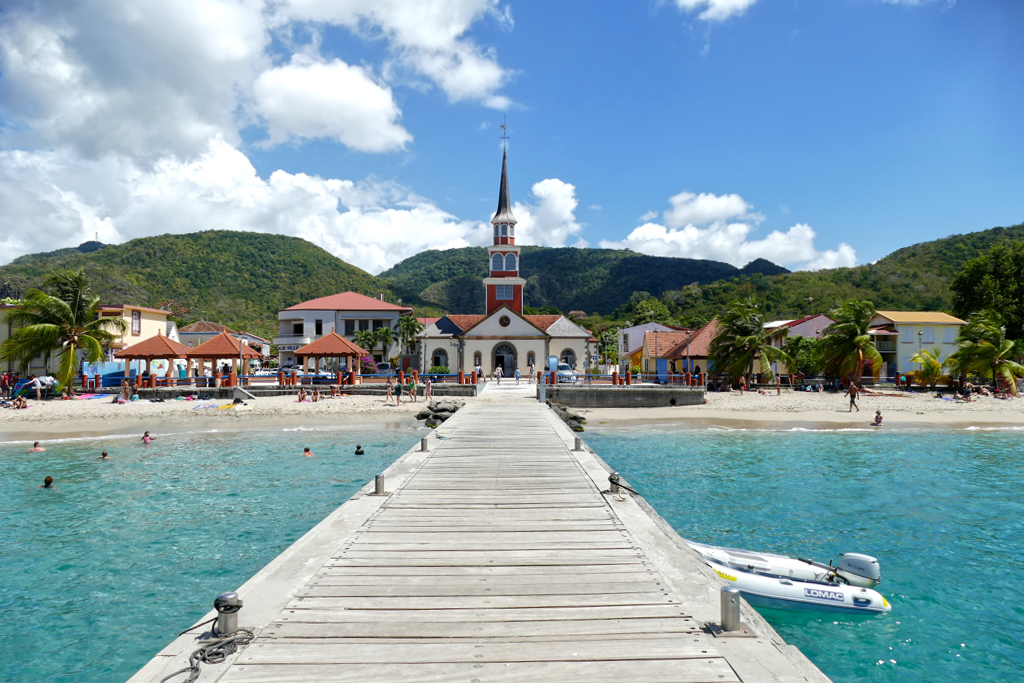
Picturesque wooden houses painted in bright colors line the road that follows the beach and leads through the village to the foot of the mountain. Opposite the Saint Henri church, a long wooden pontoon divides the beach into two parts. In 1762, the British burned the former church of Sainte Antoine down. A new house of worship was then constructed with the generous support of Henri Larcher, a wealthy citizen. As a gesture of gratitude, the new church now honors Saint Henri, patron of the childless, the handicapped, and those rejected by religious order. There you have it.
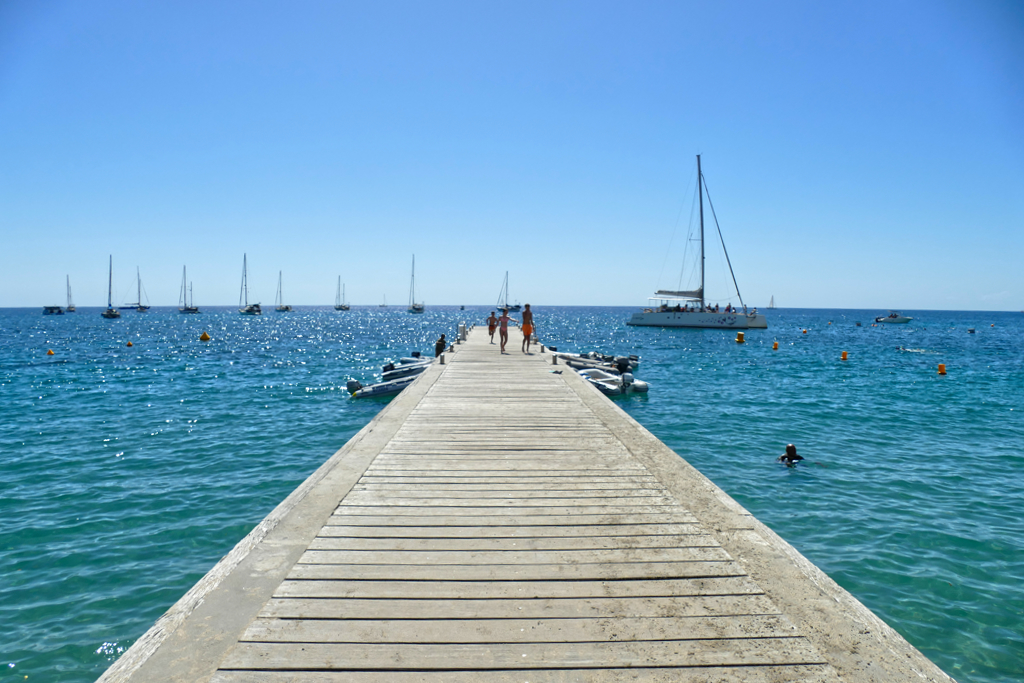
The settlement spreads over various bays such as Grande-Anse and Petite-Anse. The beaches in the south of Martinique have light sand. On the other hand, black lava sand covers the northern beaches. The peculiarity of the two bays Anse-Dufour and Anse-Noire just north of Grande-Anse is that although they are just separated by a small headland, Dufour is made of white sand, while Anse Noire, according to its name, is covered with black sand of volcanic origin. Actually, it is the only black sand beach in the entire south of the island.
Take It Easy
Although tourism is slowly but surely increasing in Les Anses d’Arlet, the region is still relatively sparsely populated and retains the serenity and charm of a fishing village.
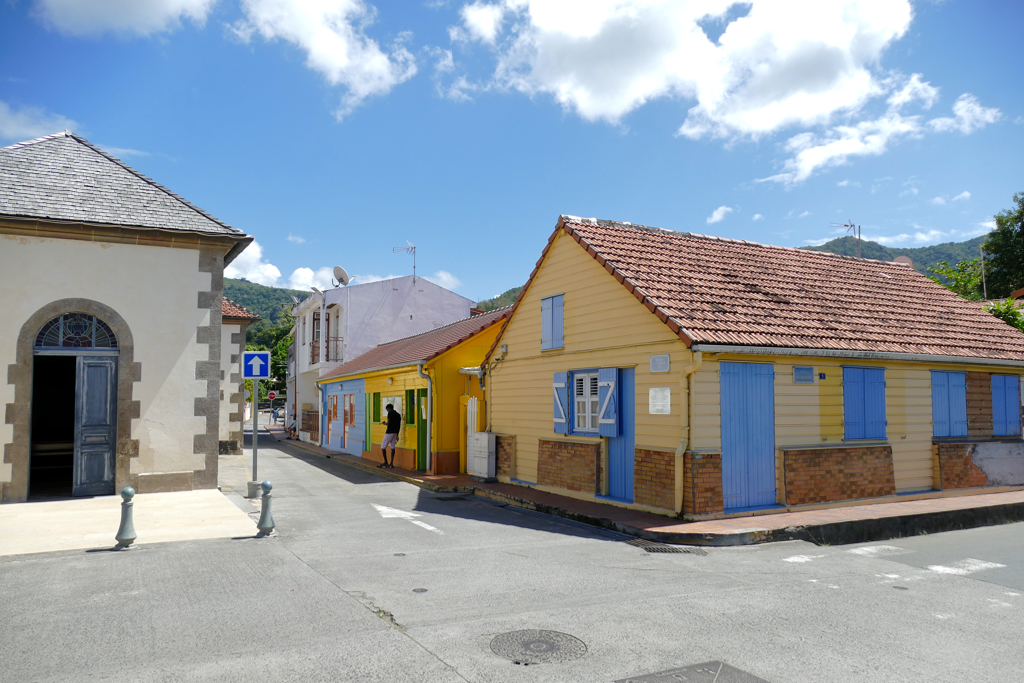
So, are Les Anses d’Arlet truly such a dream destination? Well, there is no doubt that the townlet is cute and the bays in the area are outstandingly beautiful. At the same time, they were the busiest beaches I’ve been to in all of Martinique, especially the Grande-Anse. And I was there on a weekday. I don’t even want to imagine what must be going on there on weekends. So yes, it’s worth visiting Les Anses d’Arlet but lower your expectations when it comes to paradisiacal solitude.
Also another tip: In the southern part of the island around Sainte Luce and Sainte Anne, you can do some wonderful beach hopping just by strolling from bay to bay. Unfortunately, this is not possible at Les Anses d’Arlet. Obviously, you can get to the different beaches, but you cannot walk there. You need to take the bus, and since the buses in this area are particularly unreliable, this would be rather a mission than leisure. Therefore, I recommend you pick one beach – or two at most – and spend the day there. Slow down, this is the Caribbean, after all. Don’t forget that you can always come back to experience a different beach on another day.
Le Diamant
It’s the four of us: Four women sitting on a wooden bench at an equally wooden bus stop. A small sign on the side of this shed informs us that it was financed by the European Union. I guess it’s these kinds of perks that make Martinique’s political dependence on France a tiny bit bearable.
It’s around noon and we try to squeeze in the corner where there’s still a narrow strip of shadow. The other three ladies are Canadian. French Canadian, obviously. In my four weeks in the French Antilles, I met maybe a handful of English speakers. So we chat and interchange our experiences as women travelling the Caribbean and courageous explorers doing so by public bus. It’s pretty reassuring to see that, other than in Guadeloupe, I’m not the only tourist daring to explore the island by public transport.
I’m not crazy. I’m an individualist.
And as we are chatting away, the bus approaches so we jump up and wave our arms to signal the driver that we are passengers. He sees us, slows down, approaches the curb – and then accelerates again without even stopping.
Through the windows, we see that the small van is full. Every place is occupied. Allowing more passengers would be illegal. Why should the driver risk his job for four tourists?
The Other Way Around
So far so good. The only problem is that the next bus is scheduled in almost two hours. One of the Canadians and I start to check alternative connections on our phones. Then, we come up with an alternative: We will take the bus that is circulating the peninsula in the opposite direction. This way, our trip will take more than an hour instead of twenty minutes, and the bus will be at the stop in about half an hour. However, that saves us from a long wait in the unbearably hot sun.
Said and done, half an hour later, we are sitting in a bus that carries us in a long, elegant arc through the entire north of the Trois Îlets peninsula to the famous townlet of Le Diamant.
You live, you learn: After a couple of bus trips, I was ready to put together ten crucial tips on how to ride the bus in Martinique and how to deal with minor mishaps. You’ll find the list below in the How to Get Around section.
As we get to the town of Le Diamant, we part ways. They want to take a break and then explore the settlement that takes its glamorous name from the famous rock off the coast. This tiny islet is a former pirate shelter and used to be a fortified point during the fighting between the French and English in the Caribbean. Today, it is one of Martinique’s most iconic landmarks and a very popular diving destination.
What No One Is Talking About
The town of Le Diamant is not very spectacular. There is the Église Saint Thomas which dates back to 1684. At that time, Le Diamant became an independent parish, detached from nearby Anse-d’Arlet. This meant that the town had to have its own church. However, it’s not the one that you see today as in 1766, a hurricane destroyed the original building.

About 12 years later, the parish built a new house of worship on the same site. This building was even more magnificent and, unlike its predecessor, also had a bell tower. Yet another terrible hurricane devastated Martinique in 1817. Again, it took a dozen years before the church could be rebuilt because of financial constraints. The congregation and the wealthy landowners disagreed on who should cover the major part of the construction costs.
Finally, their human possessions came to mind: slaves as currency.
To cover the costs of reconstructing the Église Saint Thomas, the local government increased taxes according to the number of slaves owned by the citizens of Le Diamant and the owners of the surrounding plantations. The more slaves, the higher the taxes.
The Église Saint Thomas was reopened at the end of 1829.
Apart from the church, the covered market west of the center is another place of interest. However, be aware that it’s not a real local farmers market but rather a gigantic yet quite charming souvenir store.
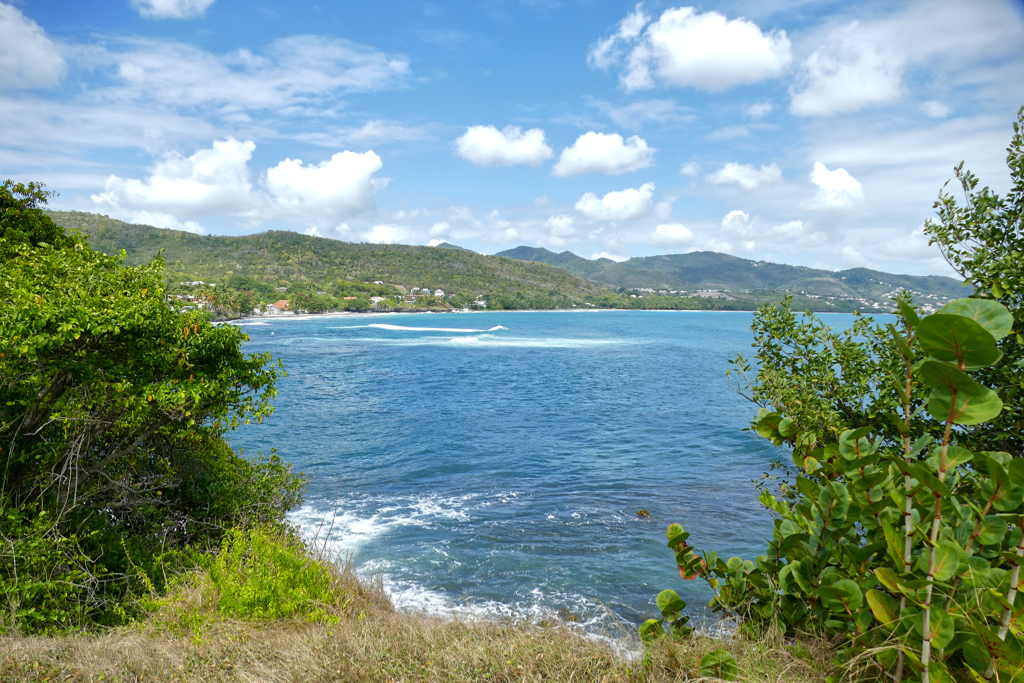
If you are into beach walks, the beach Grande Anse du Diamant is the perfect place for you. It’s about three kilometers long and runs between the turquoise waters and an overgrown forest where you can walk on well-designed trails in the shade of leafy trees.
Cap 110 Memorial
As you are hiking westwards from Le Diamant, you get to Anse Caffard, another secluded bay where you can take a break as well as a refreshing dip in the cool waters. Here, the road continues slightly uphill as you get to the Cap 110 Memorial.
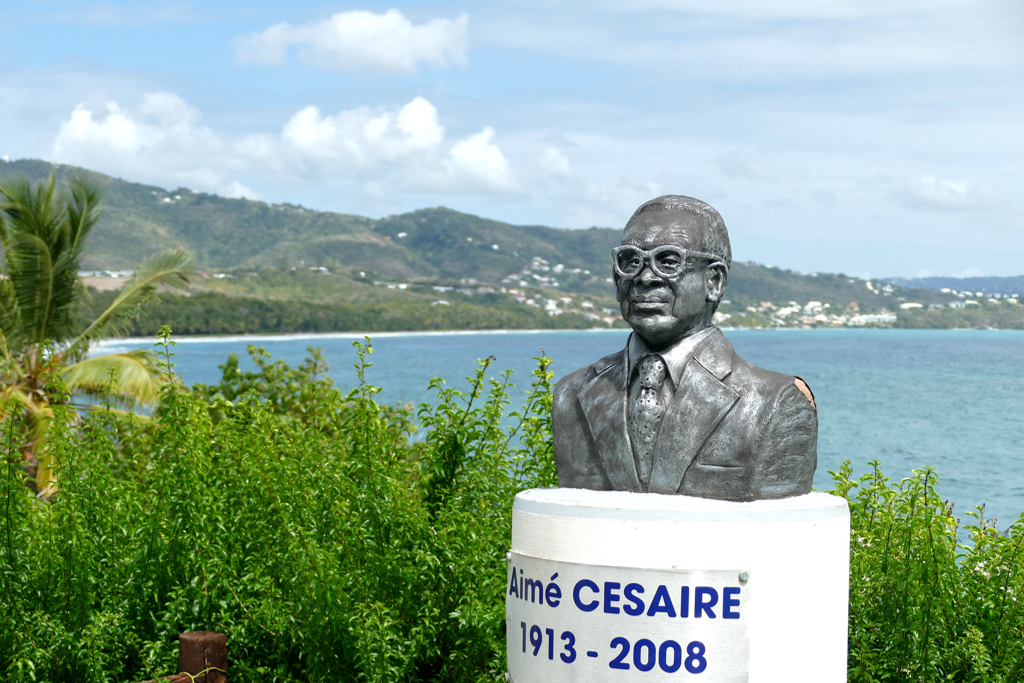
In 1830, a ship ran aground on the rocks of Anse Caffard. It was carrying illegal human freight, namely an unknown number of Africans. Obviously, they were foreseen to be sold as slaves. The slaves working at Habitation La Tournell managed to save twenty-six men and sixty women. Yet, the next day, forty-six bodies were found on the coast.
Because it was an illegal passage, the name of the ship and its unfortunate passengers could never be determined. As a result of the tragic event, the town of Le Diamant gained notoriety. Fortunately, this was the last sinking of a slave ship in Martinique’s history.

In 1998, Martinican artist Laurent Valère created a memorial on the site of the catastrophe on the occasion of the 150th anniversary of the abolition of slavery in Martinique.
Valère incorporated many symbolic aspects into his installation: The sculptures are facing towards the Gulf of Guinea, from which their ship probably came. The installation is triangular, reminiscent of the infamous triangle trade. Finally, the white color stands for grief just like in West Africa as well as in the Caribbean.
Laurent Valère also created an imposing underwater sculpture called Manmandlo in the bay of Saint Pierre.
Maison du Bagnard
Another local sculptor’s work wasn’t so well received, and the poor guy really had a hard time. For some reason, Médard Aribot created the portrait of Confederate States Army officer Georges De Coppens. In 1925, a wild crowd waved this wooden effigy during an election riot. Ten people lost their lives in this turmoil. Eight years after the riots, Médard Aribot was sentenced to life imprisonment – officially, however, for alleged robbery and looting.

Aribot spent his years in prison in Guyana. He was only released when the penitentiary closed in 1945. In 1953, he returned to Martinique. There, in 1960, he built a cute, colorful house just four kilometers west of the town of Le Diamant, where he lived until he died in 1973.
This so-called Maison du Bagnard, hence, the convict’s house, becomes a curious tourist attraction after the artist’s death. In this way, Médart Aribot and his sad fate will not be forgotten.
The small house is free-standing and can generally be visited around the clock. However, it is currently – in spring 2024 – surrounded by small scaffolding and is not allowed to be entered for security reasons. A visit is still very worthwhile.
Trois Rivières
So we are leaving the Trois Îlets peninsula and making our way towards the southwestern part of the island. Technically, Trois Rivières is part of Martinique’s Sainte Luce district. Settlers founded the hamlet in the 17th century. As the colonialists were more interested in making a fortune through sugar cane and slave labor, they named the settlement after the three rivers that join there, namely Rivière Osman, the Rivière Bois d’Inde, and Rivière Saint Pierre. That the town is named because of its rivers is true, the first part is just my sarcastic assumption.
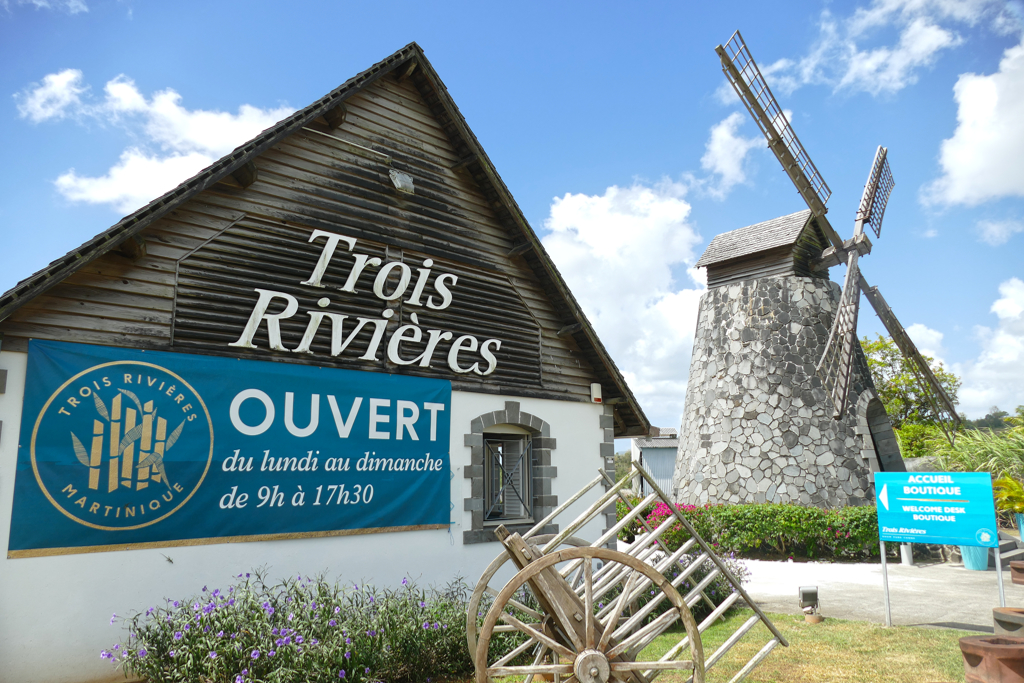
Amédée Aubéry purchased the estate Trois Rivières in 1905. He quit sugar production to exclusively produce high-class agricultural Rhum. While the stuff you pour into your Coke is made from melasses, agricultural Rhum is made from sugar cane juice.
At that time, Trois Rivières was a single main street lined with huts for the distillery workers. Today, however, the village consists of guesthouses, restaurants, and shops, especially around the Anse Mabouya beach.
Bottoms Up!
Yet, Trois Rivières’ strongest tourist magnet remains the same-named distillery. Other than at the Habitation Clément, at Trois Rivières, it’s all about the product, hence, no beautiful sceneries, no outstanding contemporary art. Just the cane and its processing. So if you want to learn how exquisite rhum is produced, this is the place to go. By the hour, an enthusiastic guide will explain all the steps from cane cutting to traditional production methods.
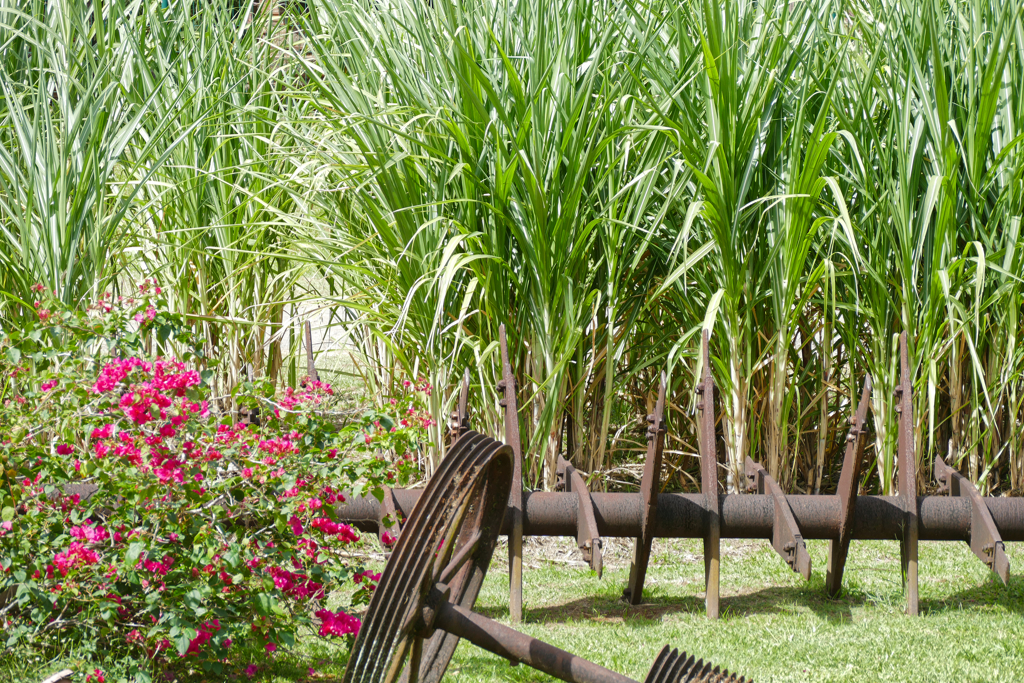
Obviously, the tour ends with a complimentary tasting. Since Trois Rivières’ cellar master was named the best of his trade in 2019 and the company Bellonnie Bourdillon & Successeurs, which owns Trois Rivières, won the Best Rum Producer and Best Spirits Producer awards in 2020, you definitely don’t want to miss out on sampling their products. Even if it’s 11 a.m. like in my case.

Also, there are three very charming gift shops on the premises so a visit to the distillery is a great opportunity to do some souvenir shopping.
The plantation and the shop are open Monday to Saturday from 9 a.m. to 5.30 p.m. A guided tour costs 8 €uros.
Sainte Luce
When I was looking for a place to make my base in Martinique, I had two crucial factors in mind: I wanted to be as close as possible to the beach and I needed easy access to public transport to explore as much as possible. And as I found Doris’ and Gilles’ apartment on Airbnb at a reasonable price and located in the heart of town, my decision was quickly made: I wanted to stay in Sainte Luce and I wanted to stay there at their Bois&Nature apartment.
I’m introducing this little gem in the Where to Stay Section below.
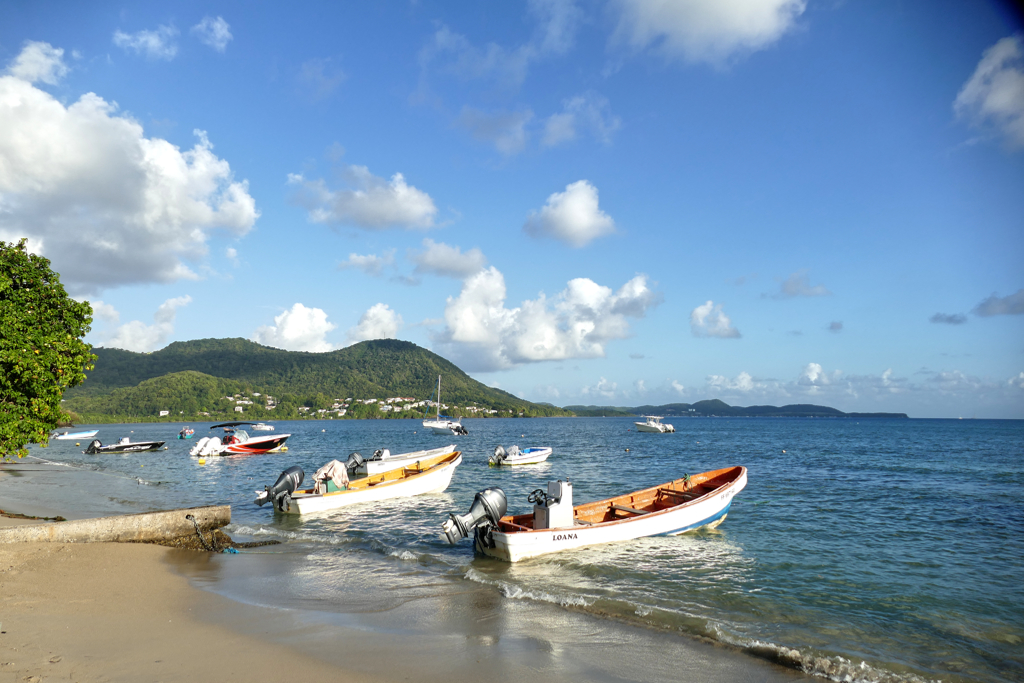
“This is where I was born and raised. I’m Saint Lucien through and through”, says Gilles as he maneuvers the car through the narrow streets of Sainte Luce and looks for a parking space. “Here you really have everything you need: a baker, a general store, a pharmacy, the police station,” he euphorically praises his hometown. “Well, I honestly hope I won’t need the pharmacy or the police station. The bakery is fine.” We laugh.
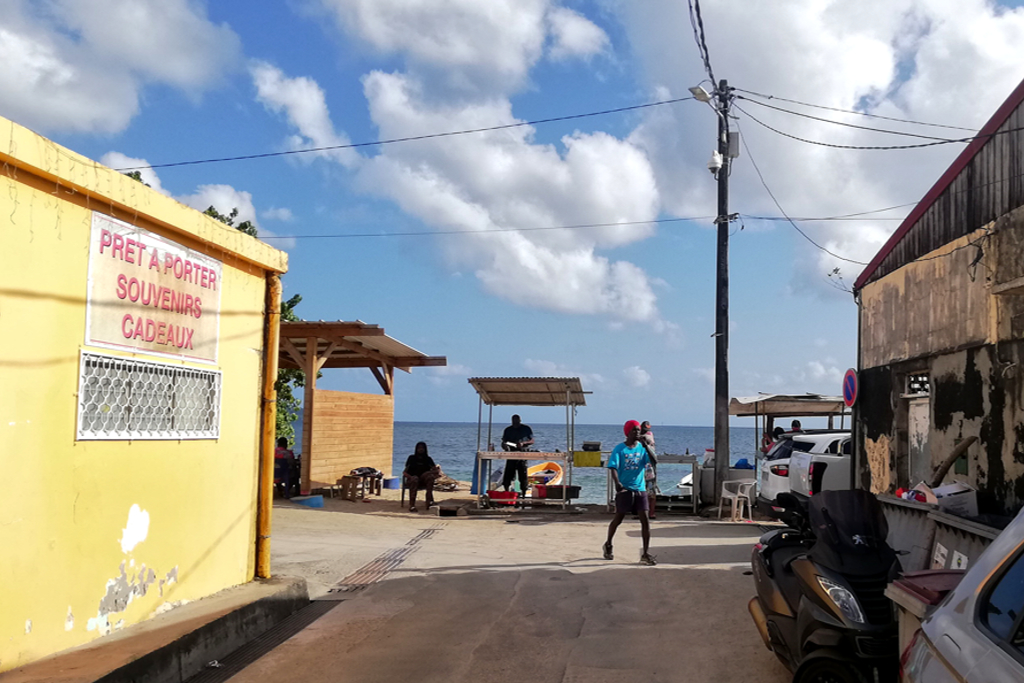
Gilles and his wife Doris run an Airbnb and they were gracious enough to pick me up at the airport. Their small apartment couldn’t be more centrally located: It’s on one of the main streets, which is of course named after the inevitable Schœlcher, and runs parallel to the well-known food boulevard Kennedy.
Settling In
At first, I don’t quite understand Gilles’ enthusiasm for Sainte Luce. Yes, it’s a nice little town by the sea, but so are others on the island, too. Yes, there is everything you need, and yet the atmosphere is still relatively untouristy and laid-back. And then over the next few days, I gradually discover how great Sainte Luce actually is.

Apart from the waterfront, which could easily serve as a backdrop for any Caribbean film, there is the mountainous hinterland and, above all, a series of dream beaches that run westwards along the shore like pearls on a string. Yes, it’s an incredible seven beaches in a row! And no, you don’t have to drag yourself and your stuff past the cars on a dusty country road to go from one to the other. No, there is a trail shaded by trees and palm trees that leads just behind the beaches from the town of Sainte Luce to the settlement of Les Trois Rivières.
Sainte Luce is also logistically very conveniently located between Le Marin and the dream beaches of Sainte Anne and the peninsula around Les Trois Îlets. If these spots weren’t so quick and easy to reach, I might never leave Sainte Luce – there’s just so much to enjoy in the town itself – why go?
Go West
There are some stretches of coast in Martinique where long beaches and smaller bays are strung together like pearls on a chain. As if that wasn’t wonderful enough, cozy paths are running along these beaches through the adjacent forests and bushes. This way, you can walk for hours in the shade of the trees. Or you just stroll comfortably from beach to beach and try out which one suits you best.
You know the old saying: Home is where you lay your hat beach towel.
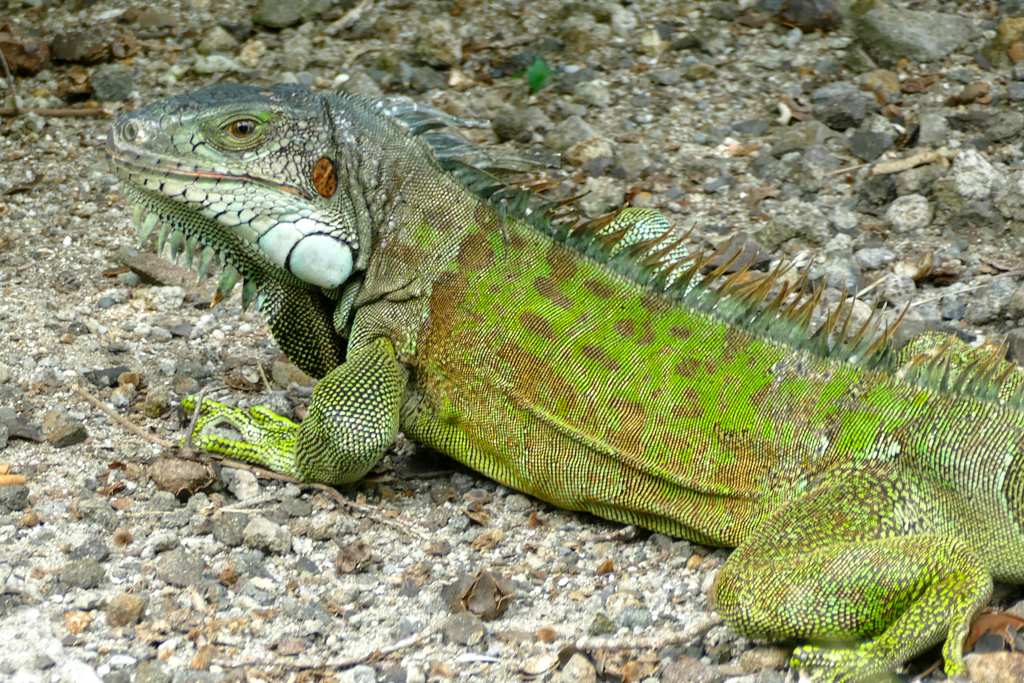
One of the finest one of those beach trails connects the towns of Sainte Luce and Les Trois Rivières.
Plage Gros Raisin
West of the village starts a succession of seven beaches stretching over five kilometers. It begins with the Plage Gros Raisin. To be honest, it’s the least alluring part as it is a very small and narrow strip of sand just below the road. However, if you just need a quick dip in the cooling waters, it’s totally fine. What I particularly liked about this beach was the small meadow on the other side of the walking trail. As you spread your beach blanket there, for once, you don’t have fine sand getting in all of your stuff.
Anse Gros Raisin
However, when I arrived in Sainte Luce, I thought the Plage was actually the entire beach. Understandably, I was quite disappointed. But just a very short walk apart is the Anse Gros Raisin, and that’s a whole different story.
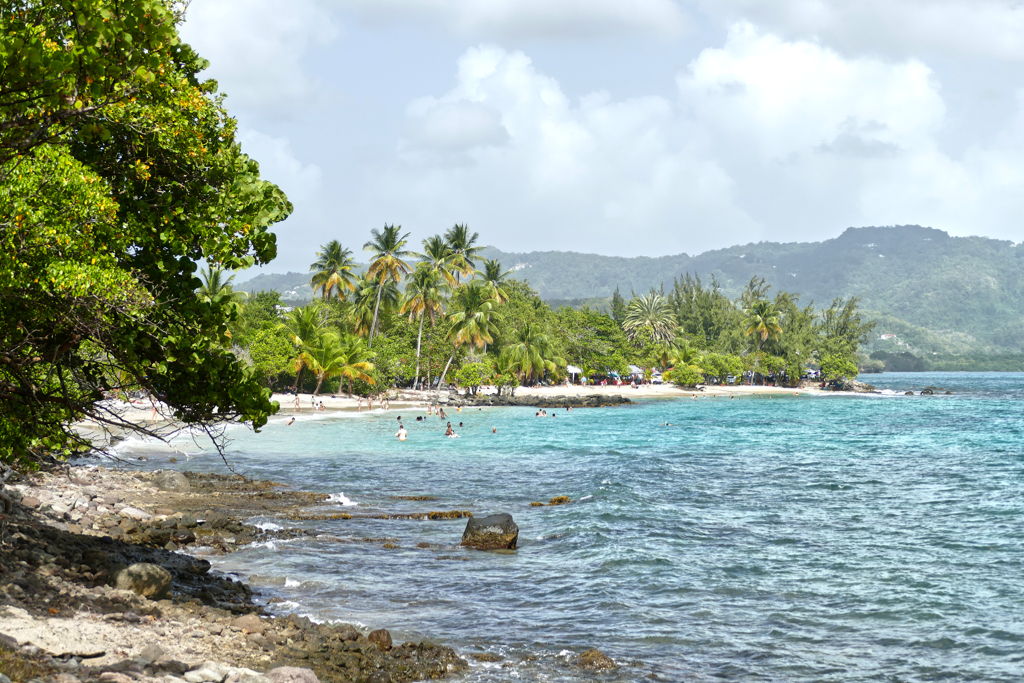
This beach is long and broad. It has two beach restaurants and is just perfect for sunbathing, swimming, and even snorkeling right off the shore.

Plage de Pont Café
Continuing the path, you’ll get to Plage de Pont Café. It consists of two parts: The first is a small cove that has a secluded and private vibe to it. The other part, however, is all the more humming. It is a fairly long beach, divided into small nooks by the shady vegetation.
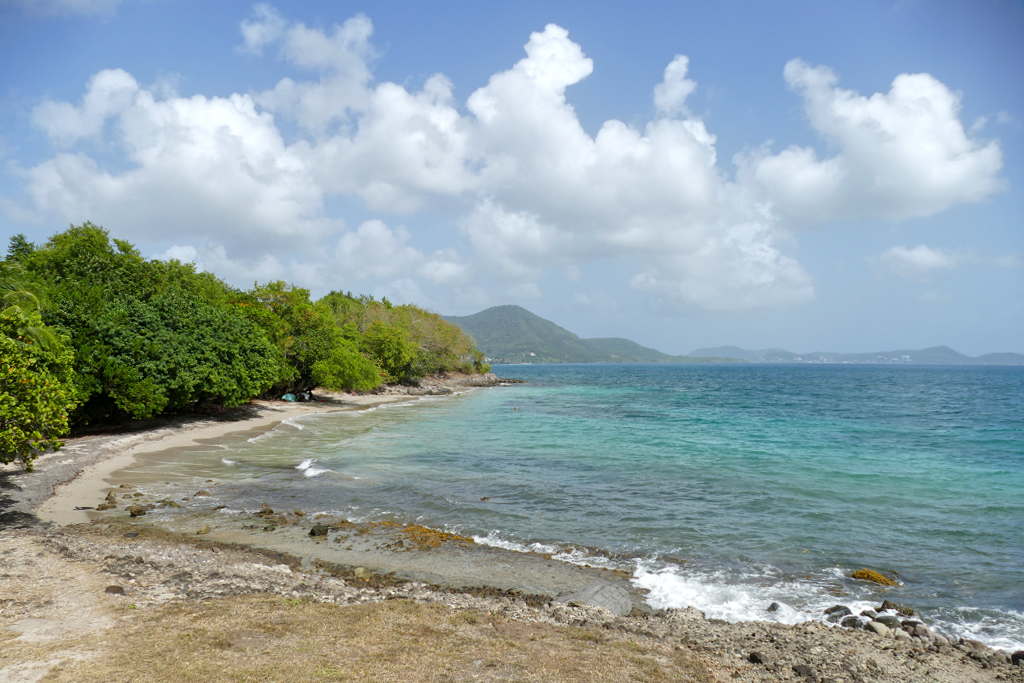
However, since the beach is right in front of the resort Pierre & Vacances, it is quite busy and they also offer unnerving activities like jet skiing. For this reason, Plage de Pont Café was just a thoroughfare for me.
Fond Banana
The next is the so-called Fond Banana. It is a long yet rather narrow beach. It is very quiet and shaded. Actually, the vegetation here is so dense that it’s easier to find a spot in the shade than in the sun. However, because of the highly poisonous manchineel tree alone, I have some concerns when it comes to tropical vegetation and make sure not to touch any plants.
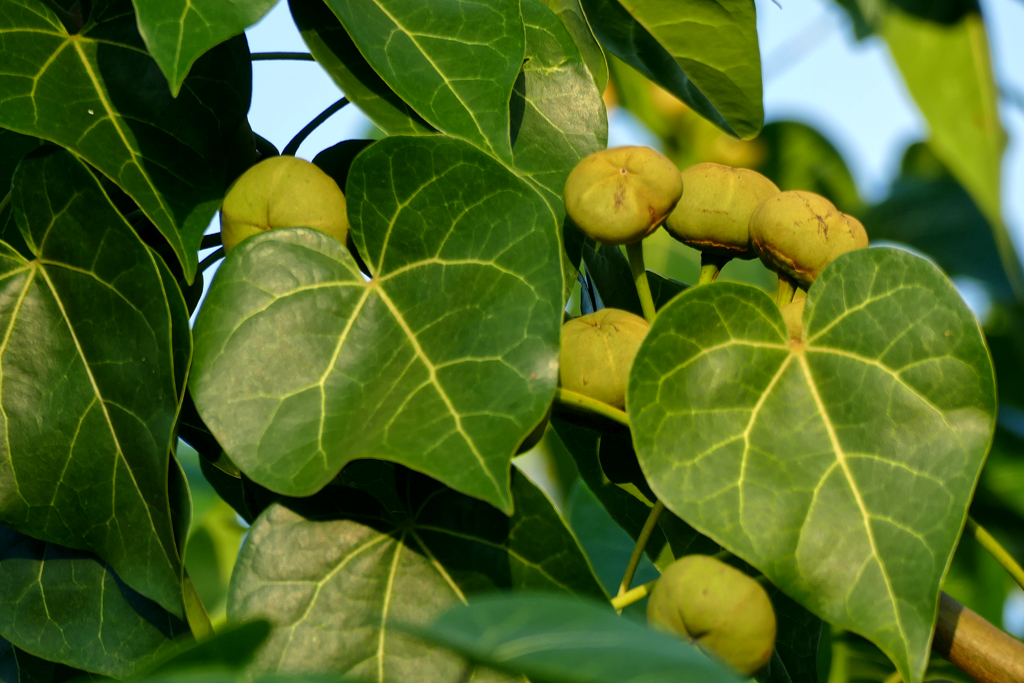
Therefore, although I love my spot in the shade, I prefer places that are not enclosed by bushes and trees. I know a lot of people like these little nooks the vegetation forms on Martinique’s beaches. They grant seclusion and privacy. Obviously, I’m also not a fan of crowded beaches. However, I don’t feel very comfortable in these alcoves.
But hey, isn’t it great that the shore of Sainte Luce offers something for every taste?
Anse Corps de Garde
As we are talking, next comes my personal land beach of Cockaigne. Anse Corps de Garde is a fairly long and broad beach in a superb cove.

It is a bit livelier than for instance Fond Banane but still far from being overcrowded. I was there on a Sunday, and although there were large families with many kids frolicking in the water and groups of jolly hikers assembled for a break, it was far from noisy or crazy.
Anse Désert
Anse Désert is very similar to Anse Corps de Garde: long and wide with many beautiful spots in the shade of sea-grape trees and coconut palms. The sand here seems actually more powdery and golden, and the ambiance is even a little more dreamy.

The only drawback: There are a lot of rocks in the water and there could also be sea urchins there. I therefore strongly recommend wearing water shoes with stable soles.
Other than that: Welcome to paradise!
Anse Mabouya
Since Anse Mabouya is the farthest beach from the town of Sainte Luce, it is rather secluded and quiet. If you don’t make it to the last stop on your beach hopping on foot but get there by car or public bus, you’ll find the entrance at the end of a dead end where boats are launched on the southern tip of Quartier Désert.
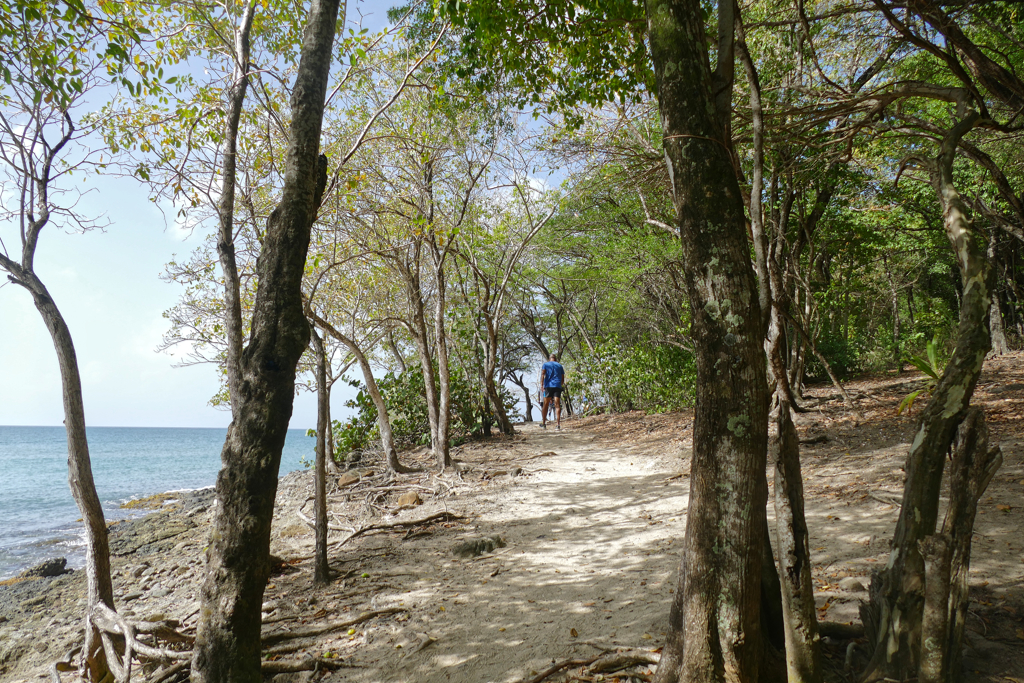
Here you can laze in the sun in the shade of mangroves and frangipani and enjoy a marvelous view of the rock Le Diamant and the Morne Larcher.
Sainte Anne
“Hey, Renata, going from Sainte Luce to Sainte Anne, there is also the town of Le Marin with its famous marina. Shouldn’t you cover this important hub, too?” I hear you asking. Well, not really. While it’s definitely correct that Le Marin has a giant marina and is a major hub – by the way, not only when it comes to leisure seafaring but also regarding terrestrial traffic, the place as such doesn’t have much to offer.
There is a baroque church Église Saint Étienne and most importantly, there is a surprising number of shopping centers and major stores of all kinds. But that’s about it. Going from Sainte Luce to Sainte Anne – whether by public bus or by any other means of terrestrial transportation – you can always include a short pit stop in Le Marin. And in the end, I’m sure you’ll agree with me that it was more than enough.
As you make your way from Le Marin to Sainte Anne, you’ll pass the entrance to the Plage Municipale, the city beach.

Facing west, the beach stretches over five kilometers. It consists of fine sand lining clear turquoise waters and offers amazing views of the entire coast all the way to Le Diamant.
Trees and palm trees provide shade. In between you can fortify yourself in one of the many small makeshift snack bars and eateries, although I personally find them a bit overpriced. So bring your own picnic.
It’s Public
In the 1960s, the Club Méditerranée hotel chain opened one of its complexes in the Pointe Marin beach area. Like the Caravelle Beach in Guadeloupe, this part of the shore is primarily used by hotel guests, but it is public and can be accessed by anyone. Of course, this only applies to the beach itself, not to the facilities. So if you spread your towel right next to a hotel lounger, that’s weird but not prohibited. On the other hand, you are not allowed to use the shower next to it or hop on one of their surfboards, obviously.

Now, the Club Méd portion of the Pointe Marin beach is so small that you can easily do without it. I just wanted to point out that this is a publicly accessible beach as you have to cross it to get to the top. From there, you have another fantastic view, this time on the marina of Le Marin and the mountains behind. Hence, don’t miss out on a walk along the entire beach.
Never Forget
A noticeable difference between Martinique and Guadeloupe is that the latter has a strong vibe of determined resistance. You can feel this in the locals’ rather reserved or dismissive attitude. You can also notice this because, for example, there is a sculpture at every town’s entrance honoring the liberation from colonial slavery. In contrast to Guadeloupe, Martinique has not been able to get rid of the so-called Békés. On the contrary: A relatively small group of descendants of ruthless plantation proprietors and slave owners that today make up less than one percent of the population still holds the vast majority of wealth on the island. And with wealth, of course, comes political power.

Therefore, I found the open-air exhibition of influential black men and women who have contributed to liberation and black pride in their works or with their activities all the more gratifying.
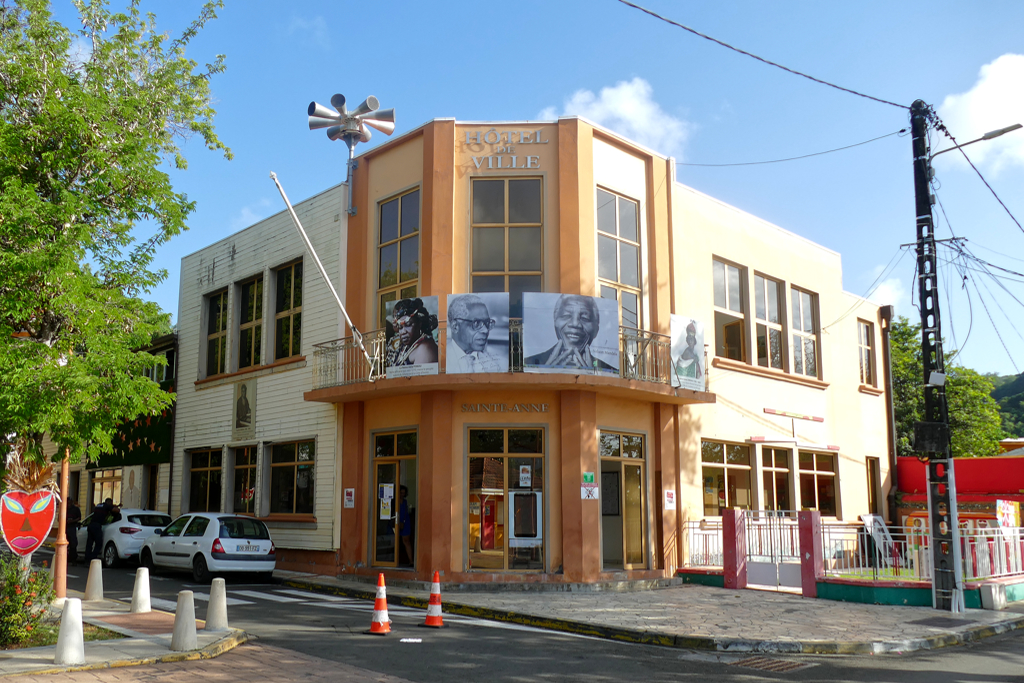
So before hitting the road to enjoy yet another amazing beach hike, it’s definitely worth it to take a look around at Sainte Anne’s small town center. Here you get to see a series of huge portraits of black leaders displayed in the Place de L’Abbé Morland square in front of the Eglise Notre-Dame as well as on the façade of the town hall.
Coastline Hike
I must say I really got into this beach hopping on foot. Many of Martinique’s coasts are just the ideal places to alternately stroll along the beach and take a refreshing swim as it gets too hot. At the last spot, I lay down in the shade of a palm tree and read a book until my eyes closed and I gently slid into a little nap.
I’d argue the coastline south of Sainte Anne offers the most alluring bays. You are hiking from cove to cove on a comfortable trail in the shade of a thousand beautiful trees before you finally reach the Anse des Salines, the grand finale.
At least for me, this was the final point. Others continue from here to the famous Savane des Pétrifications for one of the island’s most popular hikes. Different volcanic eruptions created this part of the island. Its name comes from the petrified trees which have vanished eventually. As I explained above, I’m very careful before setting off for a hike after my accident, hence, the Savane des Pétrifications is one of the places for which I’ll have to come back to Martinique as soon as I can.
Plage Anse Tonnoir
However, I set off for an amazing beach hopping. Although I must say that already the first beach that is still within the city limits of Sainte Anne was very tempting.
It is just a small stretch of sand south of the town’s picturesque fishing harbor from where you have a great view of the entire west coast.
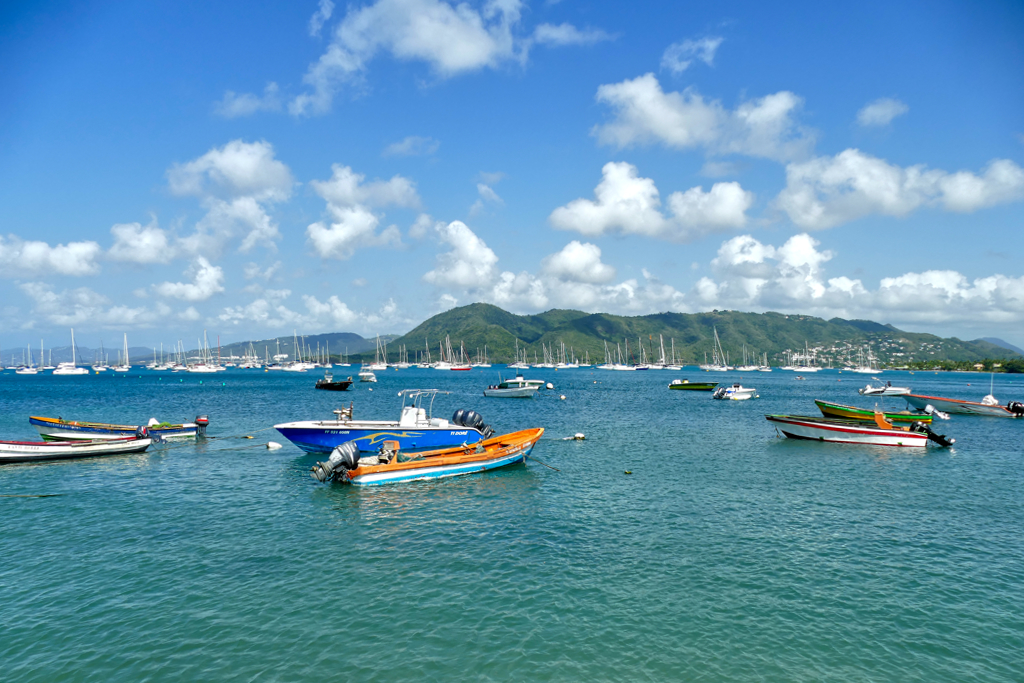
It’s a bit unfair: In any other place in the world, you would love Plage Anse Tonnoir! The sand is white, the water is clear, and there are plenty of trees so you can relax in the shade.
On an island like Martinique, which is lined with beaches that are otherwise only known from ads, a beach drops in the ranking due to even the slightest imperfection. As a matter of fact, Plage Anse Tonnoir’s only imperfection is that the beach borders directly on the city and I also wanted to see the other dream bays. No, there was no way I could finish an hour-long hike after five minutes on the city beach. Other than that: This beach is absolutely fine if you have no ambition and just want to laze around in the sun.
Plage de Anse Caritan
Hence, instead of spreading my beach towel right on Plage Anse Tonnoir, I made my way up the road and turned left following the sign Plages.
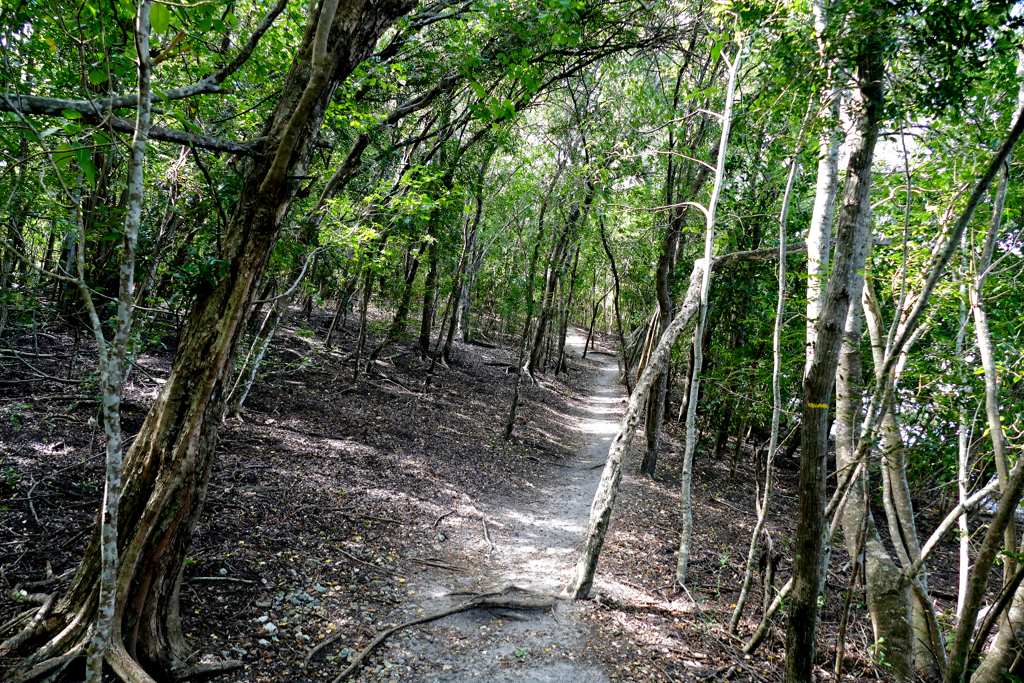
After less than one kilometer, I got to Anse Caritan which marks the start of the so-called Trace des Caps hiking trail. It is a rather narrow white sand beach. At high tide, it is sometimes completely covered with water as the strip of sand is so thin. Just like at Fond Banana in the Sainte Luce area, you have to make yourself comfortable in little nooks amidst the dense vegetation.
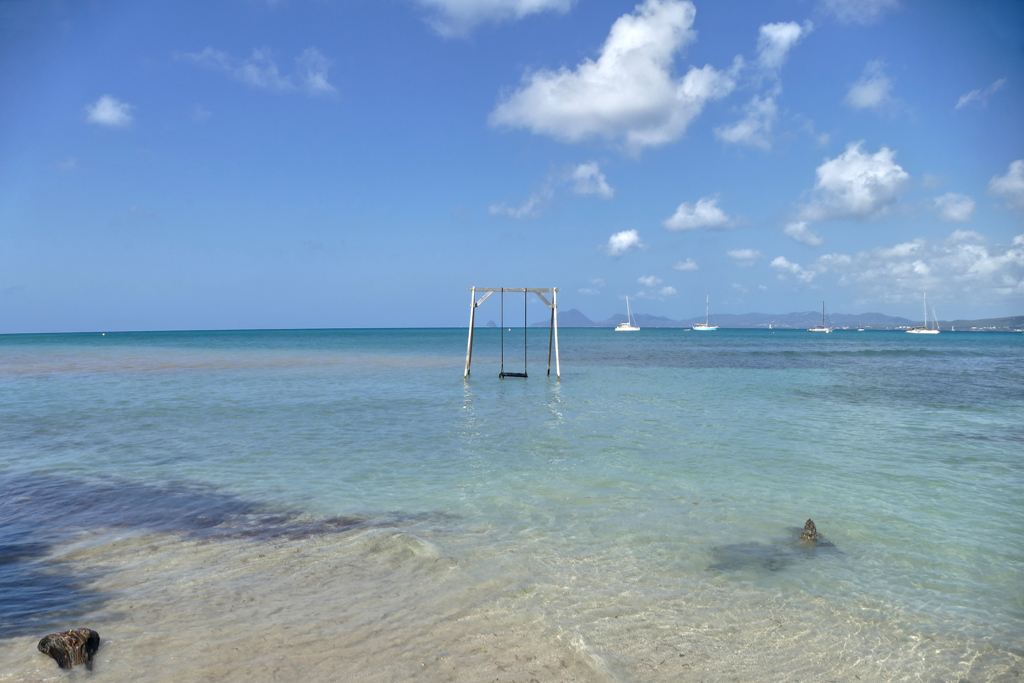
However, as Anse Caritan is next to a spacious hotel complex, there are always quite a few visitors. As the shore is well-protected from waves by the protruding Sainte Anne peninsula, it is also appreciated by families with young children. Especially as they can enjoy all kinds of slides and trampolines at the small water park Maya Beach Club. Nevertheless, with a fee of 10 €uros for an hour, it’s not exactly cheap.
To enjoy some fun in the sun for free, make your way to the Balançoire, an off-shore swing located more or less exactly where Anse Caritan merges into Anse Meunier.
Anse Meunier
Anse Meunier’s coves are a bit more spacious than those of Anse Caritan. It’s a truly magnificent beach with clear and rather shallow water perfect for a swim during your hike.
Here too, shrubs have formed nooks’n’crannies, however, they have a less cramped feel to them.
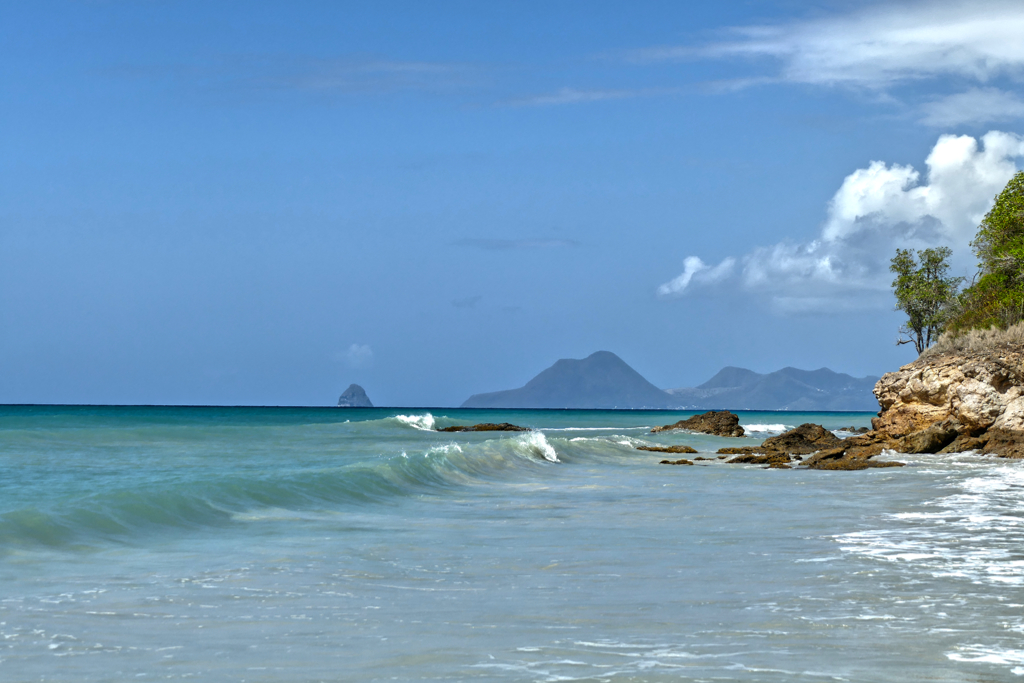
After a refreshing dip and a thousand pictures of the open sea with the rock and the coastline of Le Diamant in the backdrop, let’s continue our walk.
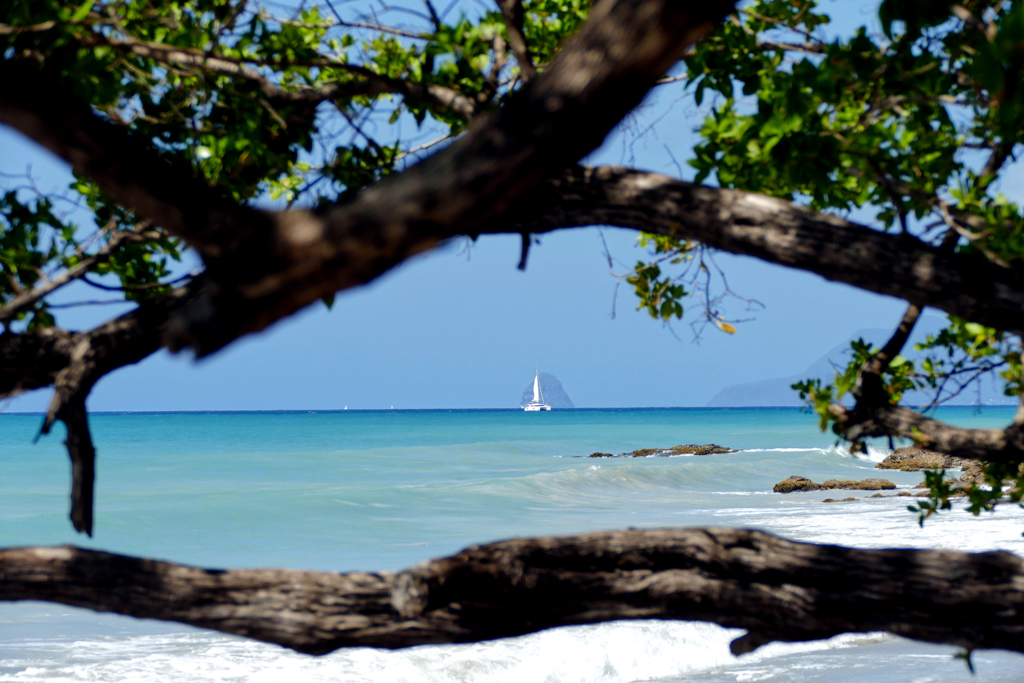
The closer you get to the so-called Pointe Catherine, the broader the beach gets. Slowly, you get an idea of what to expect at Anse des Salines.
Pointe Catherine is a headland separating Anse Meunier from Anse des Salines. As it protrudes into the sea at a height of about twelve meters, you absolutely need to make a small detour to enjoy the marvelous views from there.
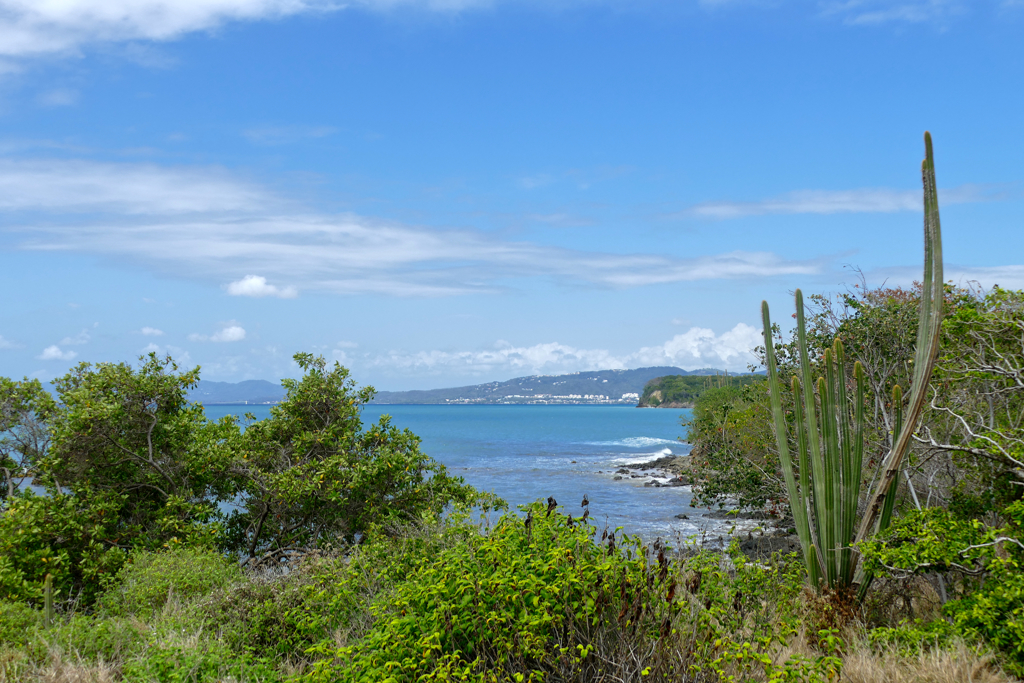
What’s also interesting is that this is the only area where you get to see cacti.
Anse des Salines
Then, as you walk back down from Pointe Catherine, you already spot the first part of the legendary Salines beach, presumably one of the most beautiful beaches in the entire Caribbean. Nature divided it in three parts. The first one is the Petite Anse. It is much less frequented than its big sister behind the next promontory. However, it is preferred by naturists, hence, if you are into textile-free swimming and sunbathing, this might be the perfect spot for you.
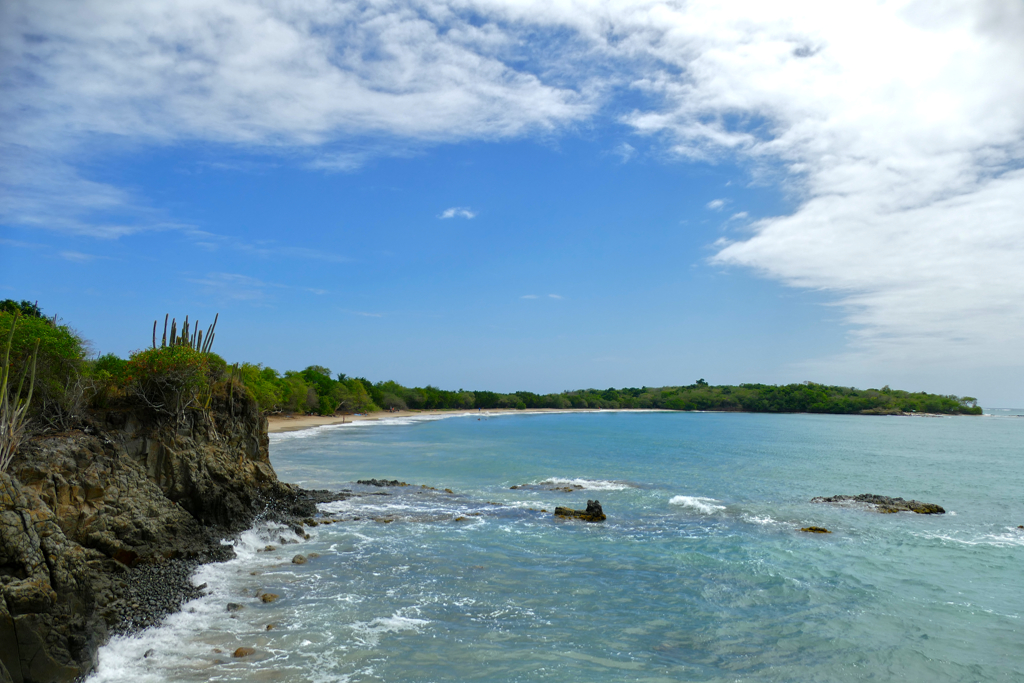
Nearly two kilometers long, Grande Anse des Salines is undoubtedly the most famous beach in Martinique. It is truly magnificent with its fine white sand protected from the scorching heat by seagrape trees and palm trees. By the way, the white sand of the Caribbean is in fact only eroded calcite from shells and corals.
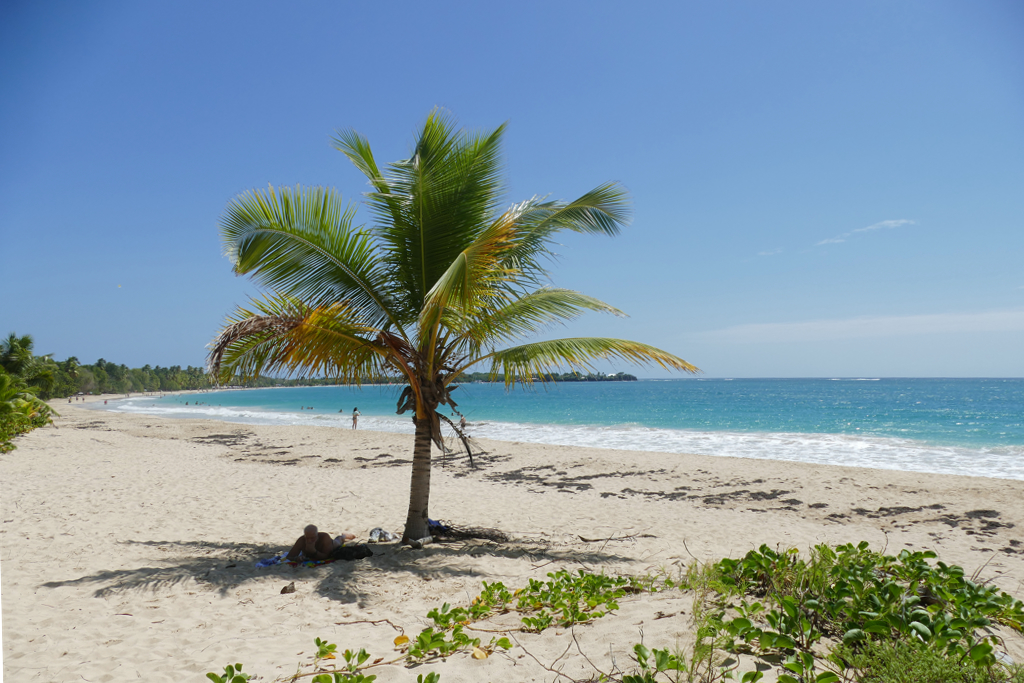
It will come as no surprise that a magnificent place like this attracts lots of admirers. Therefore, it is busy all year round. You’ll find a bit more privacy on Petit Anse as well as the Grand Terre beach which is the last segment of Grande Anse des Salines.
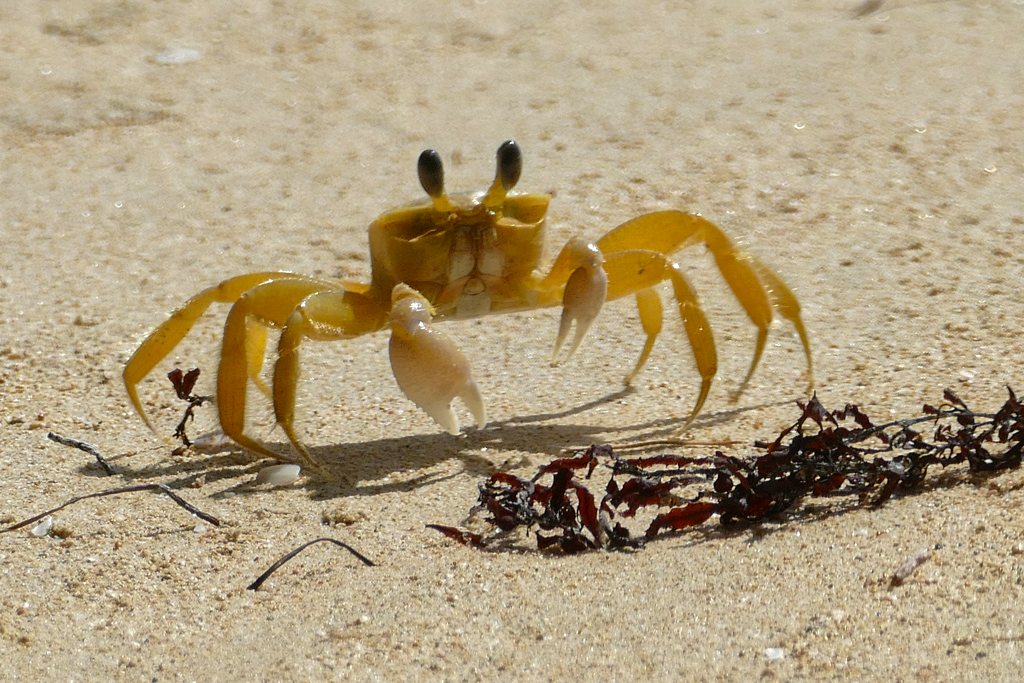
Grande Anse des Salines owes its name to the brackish water lagoon located just behind the beach. Surrounded by mangroves, it is perfect for bird-watching. This is also the starting point of the very popular hike across the Savane des Pétrifications.
Practical Information
It is completely incomprehensible that beautiful Martinique is visited almost exclusively by the French. Yes, politically and administratively, the island is actually one of the 101 French Départments. On the other hand, it is precisely this status that makes visiting the island particularly easy even for other nationals: You are basically travelling to France. Extending your passport, requesting a visa, and getting some strange currency? All this is of no concern when planning a trip to Martinique. You pay in €uros, and if you are an EU citizen, your ID card is sufficient for entry.
So, what are you waiting for? Off to Martinique!
How to Get There
Air Travel
Coming from Europe, Asia, and Africa, you’ll probably have a connection in Paris. From Charles de Gaulle Airport in Roissy, Air France flies at least once a day to Fort-de-France. However, note that more flights are going to the French Antilles from the airport in Orly for the sole reason that that’s the hub for domestic flights; and the Antilles are national Départments.
By the way, if your layover is a bit longer, you might want to pay the city center a quick visit. In this case, make sure to check out my post 24 hours in Paris!
From the US, there are direct flights from various cities such as Miami, San Francisco, and Philadelphia.
Obviously, you can also fly between the Lesser islands. For instance, Air Caraibes has several flights between Guadeloupe and Martinique every day. They take about 40 minutes and cost around 100 €uros.
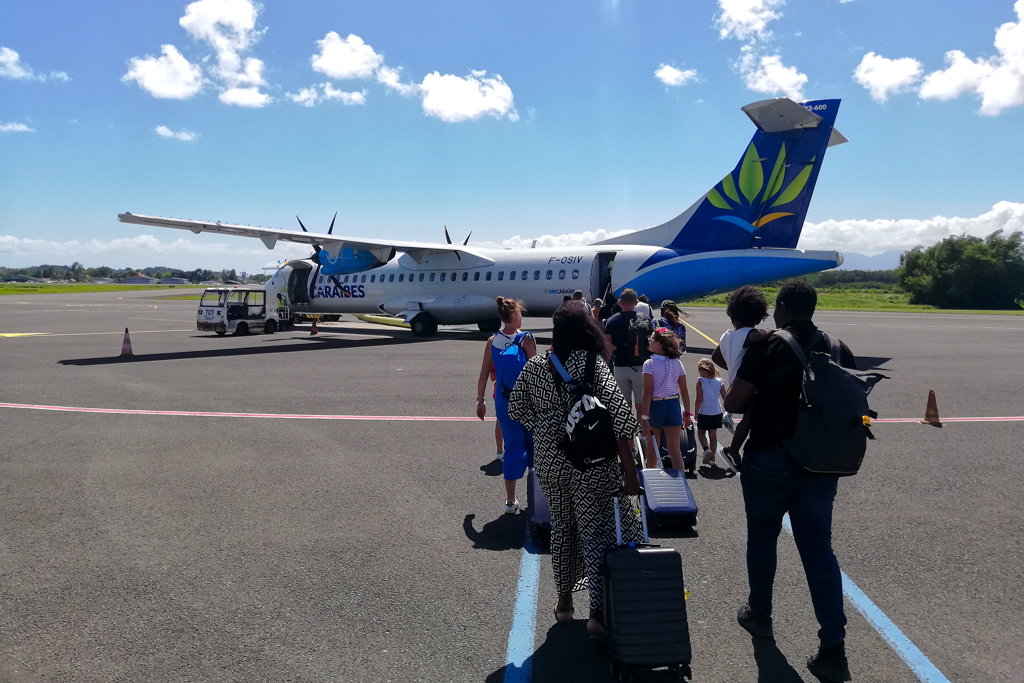
The Aimé Césaire International Airport is located east of the capital Fort-de-France in Lamentin. Most visitors pick up their rental car right at the airport to get to their accommodation. Of course, there are also taxis. In Martinique, the tariffs are fixed. There is a basic price of 3.71 euros, then, each kilometer costs 1.88 euros on weekdays, outside of these times it increases to 2.58 euros. Accordingly, a trip from the airport to Le Marin, for example, would cost around 64 euros on weekdays and take just under an hour.

If you take the public bus for this route, it will take almost twice as long, but you’ll pay only around 4 euros. You first have to take line #A to Carrere, which is four stops and four minutes away. From there, you take the express bus #01 that goes also to Rivière Salée and Sainte Luce. This option may be more recommended for your return journey when you are already familiar with the island and the bus system. As you arrive after a long-haul flight, your comfort should certainly be a priority.
By the way, you can find more tips for safe and worry-free solo travel in my post How to Surpass Pre-Travel Anxiety.
Sea Travel
If you are already in the Caribbean, in addition to air travel, you can also travel by ferry. The shipping company Express des Iles runs regular ferries between Guadeloupe, Dominica, Martinique, and Saint Lucia. A one-way crossing starts at 59 €uros, and the journey between Guadeloupe and Martinique takes around 4.5 hours. You’ll reach the other islands after only 1.5 to 2 hours. However, you can check all prices and connections on the company’s website.
How to Get Around
When planning my trip to Martinique, I heard that public transport is neither comprehensive nor reliable. I would definitely need a car to be able to enjoy the island to its full extent. Well, I don’t know exactly what the full extent is supposed to be. However, after almost two weeks in Martinique, I can say that I got everywhere I wanted to go by local bus.
The bus network is well developed, I can’t think of any place that doesn’t have a bus service. Some places are also served by several lines. The network is divided into south, central and north, a journey between towns costs around 2 euros, journeys with local buses cost 1.50 euros. You can purchase a season ticket or buy tickets using the App MT Ticket. It was too much effort for me for almost two weeks on the island, so I bought my ticket from the driver every time.

Yes, there are plenty of buses that go to the most remote corners of the island. However, you often have to change buses at least once; for longer distances, this can sometimes take three or four legs.
But Renata, that’s not so bad.
Better Late Than Never Early
Well, hold that thought. I’m afraid you’ll change your optimistic attitude when I tell you that the waiting time for the next bus is often half an hour, but sometimes also 45 minutes. And that’s according to the schedule. In addition, your first bus may have been particularly fast so that you arrive at the connecting stop ten minutes before the scheduled time, but the next one is fifteen minutes late. Now calculate the waiting span in real time and the whole thing doesn’t sound so great anymore.
Obviously, these are extremes. If this kind of connection was always the case, I certainly wouldn’t be promoting enthusiastically taking the bus. However, a very long wait can occur. One consolation: the most important junctions where I had to wait for long were always at a roundabout where there was at least one major supermarket. So I simply used the waiting time to do my shopping – either refreshments for the beach or groceries for my apartment. That was very practical, I just had to keep an eye on the time and remember that the next bus could come ten minutes earlier than scheduled, so I had to make it back to the stop in time.
Prepare
With very few exceptions, I think it is essential to check your connection options for the day and, if possible, write them down so that you don’t get confused. You can easily check routes on Google Maps. Simply enter the start and destination and the desired departure or arrival time. Then click on the little bus symbol and you will see all the options. Things get a little better with the App Martinique Mobilité. It works the same as Google Maps, but you can easily save the connections and don’t have to write them down or remember them.
Extra Tip
A ferry runs about every hour across the bay between Fort-de-France and some spots on the opposite peninsula. Not only is it idyllic, but it is also often quicker if you come from the south. The round trip costs 7 euros, so it’s a little more expensive than the bus, but it’s definitely worth the money.
Ten Crucial Tips For Exploring Martinique By Public Bus
- The most important tip to make your bus ride at least tolerable: Do consider the passage a valid part of the whole experience.
If you consider your bus ride a wasted period of time between two meaningful activities, you’ll get mad. Think of it as an original tour in an authentic vehicle: Look out the window and enjoy the amazing scenery, the turquoise waters, the endless sugarcane fields, the swaying palm trees. Try to get a good glimpse of the towns and villages. Watch passengers getting on and off, see what they are wearing, what they are carrying.
This is neither New York nor Paris nor Tokyo, this is a Caribbean island, and the bus ride is part of the whole experience. So do yourself a favor, reset your watch, lean back, and go where and when the bus takes you.
————————————— - Don’t plan too much for one day. One or two destinations will be enough. Yes, in cities like London or Berlin, you can design a meticulous program for the day and follow through. Taking a day trip on public buses in Martinique is much more complicated and tiring: you’ll be walking quite a bit, you’ll have to carry all sorts of stuff with you, you’ll have to plan for longer waiting times, and all this in the tropical heat. Believe me, I’m a trooper when it comes to itineraries. That’s why I planned five spots on my first day. I would have even completed the program. But in the afternoon, I was completely exhausted, so I postponed the last stop to another day. From then on, I limited my itineraries to two spots. This way, I was often back around 3 p.m. and had still two or three hours left to relax on the beach with a nice book.
————————————— - However, plan your trip as thoroughly as possible in advance by using Google Maps or the App Martinique Mobilité. Yet, since the buses are not a hundred percent reliable, stay flexible, don’t freak out, and consider an alternative connection as you go.
————————————— - Be at the stop at least ten, better 15 minutes before the scheduled time.
————————————— - While waiting, don’t get distracted by reading or chatting with others. Keep your eyes on the road if the bus is coming. Because if you just hang around at the bus stop, the driver won’t consider you a potential passenger and might just merrily pass you by. As soon as you see the bus approaching, give the driver a sign by lifting your arm or waving.
————————————— - Keep in mind that the vehicle might look different than you expect it. Instead of a large coach, it can be just a middle-sized white van with the number on a piece of paper in its windshield. This info is relevant as you have to flag the bus down. It happened to me that for some reason, I expected a certain bus to be big and colorful. Only as a white van raced past me did I realize that I just missed my bus.
Therefore, it’s better to wave frantically to a potential vehicle once too much than let it pass you by.
————————————— - Make sure to have small change to pay your fare as the drivers accept only bills up to 10 €uros.
————————————— - Try to take the bus at the final stops respectively as early as possible: If you have the choice between two stops, wait at the one the bus serves first. Mind you, once all the seats are taken, the bus is full and the driver will leave you standing at the bus stop. Especially in areas where there are only a couple of those smaller vans a few times a day as well as during rush hour in the afternoon, it is the survival of the fittest.
————————————— - Never rely on the last possible connection or the latest scheduled coach. Plan your trip in a way that you can take at least one later bus.
————————————— - Even if you are totally opposed to hitchhiking, consider hitching a ride your last resort. Never have I ever hitchhiked before, yet, Martinique’s bus drivers made me leave that comfort zone right on my very first day on the island.
Organized Trips
As I pointed out, most of Martinique’s wonderful places can be reached by public bus. However, this will cost you some time and possibly a lot of nerves. Hence, an organized tour might be a more suitable option, especially if you don’t have much time on the island. Also, if you want to engage in activities on the water like sailing or snorkeling from a boat, you have to go on a tour unless you bring your own yacht.
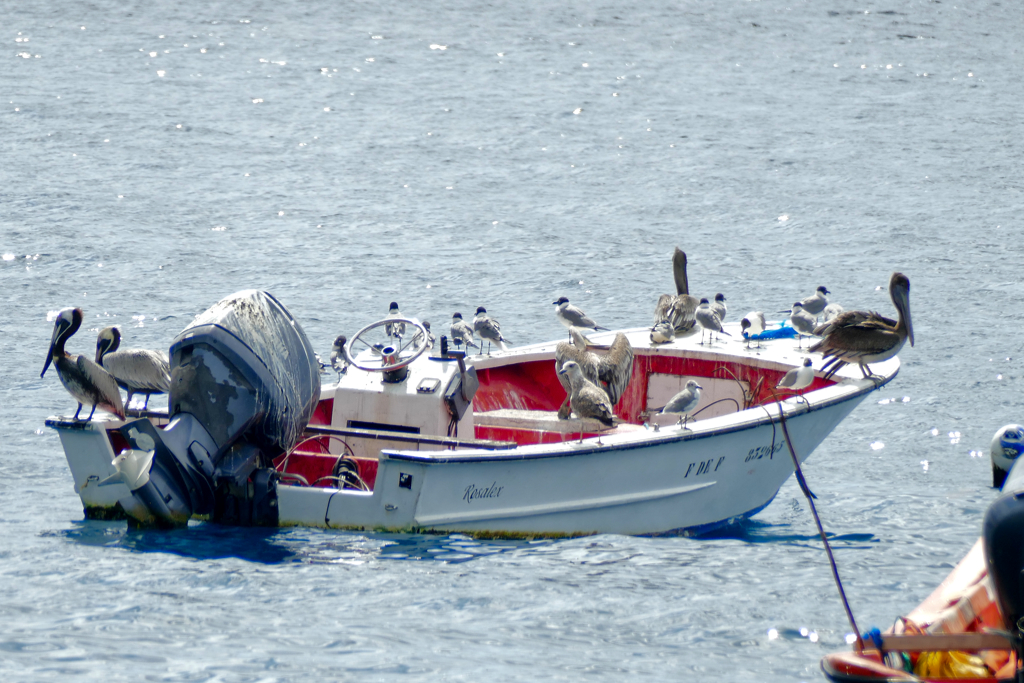
Therefore, here are some great tours to choose from*:
Where to Stay
All things considered, your lodging choice should primarily depend on what you are planning on doing. Also, you are obviously more flexible if you’re renting a car which I didn’t.
If you are planning on spending most of the time on Martinique’s marvelous seaside, you’ll probably opt for a town or village in the south where you have a wide choice of pristine beaches. If you are rather into hiking, you better find accommodation further north. Either way, I’d argue that given Martinique’s comparatively small size, you don’t need to look for lodging options in different spots. We are talking about a length of less than 75 kilometers and a width of almost 40 kilometers, hence, distances that can be covered relatively quickly.
Wherever I Lay My Hat
When I was looking for a home away from home, I wanted to be within walking distance of a beach, and I needed easy access to public transportation. I found both at the apartment Bois&Nature located in the very heart of Sainte Luce.

The world’s best bakery is right next door, a small supermarket three and the town’s central bus station about five minutes from my door. Restaurants and eateries are all around, and you reach the first of a row of beaches within less than a ten-minute walk.
Yes, I rented an apartment and so do many visitors. There are hotels mostly in the area around Pointe du Bout, and there is a Club Méditerranée on the outskirts of Sainte-Anne. However, lodging options can get quite pricey, and you’ll spend probably only a couple of hours at night in your room, anyway. Also, dining out is not exactly cheap on the island so preparing your own meals at least from time to time will save you some money.
At the end of the day, it totally depends on your preferences and your budget if you choose a luxurious room at a fancy resort or if you go for a cozy apartment rented out by a local. Either way, you can check out the availability and prices of various lodging options around Martinique on Expedia*:
What to Eat
Caribbean cuisine combines the culinary traditions of all the peoples who have lived in the region. That sounds like a pleasant mix of cultures, but we all know how this often involuntary migration came about. Whatever the case, Creole cuisine is a vibrant mix of African, French, and Asian dishes. It combines lots of spices and different flavors.

Martinicans are very much into starters, and one of the most unique ones is the Féroce. It consists of mashed avocado mixed with shredded cod, cassava flour, and chili pepper. Another must-try starter are Accras, small fritters with cod, shrimp, or vegetables. You know that the cook knows his trade when they are crispy on the outside, yet inside still soft and creamy. Other popular starters are stuffed crabs and boudin, a local sausage. There are various kinds like the one made of bacon and pig’s blood or an even more exotic one made from seafood. Many restaurants offer varied starters in one platter to try.
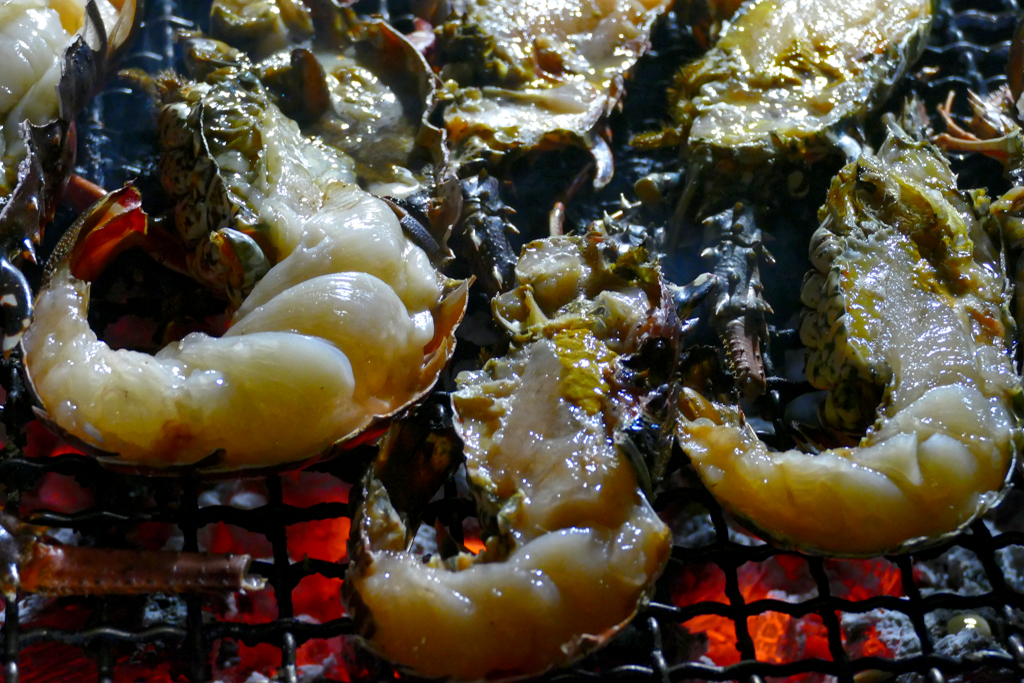
Now let’s continue with the most iconic main courses. Obviously, there is lots of fish and seafood, we are talking about an island, after all. But the traditional cuisine also includes meats, mostly chicken. It can be grilled on charcoal in cut-open barrels or smothered in a spicy curry sauce called Colombo, to name just two variations.
Quick Snacks
Obviously, you can eat at many classic restaurants. However, don’t underestimate the many fast food eateries that you’ll find in towns’n’villages. Albeit, the term fast food is misleading since these snack bars cook their delicacies actually with lots of love and time before they keep them hot on a counter so you can grab a quick lunch. A downside might be that you can enjoy these delicious meals solely at lunchtime.
One good thing about French influence is the countless bakeries that you can find in every town and even the smallest village. Baguette, croissants, pain au chocolat, chausson aux pomme that literally melt in your mouth. Yes, just like in France. There are also quiches, puff pastries filled with minced meat, and juicy sandwiches. In any case, your snack for the beach day is ready and waiting for you at the boulangerie.
Finally, don’t forget to stock up on fresh fruits. You’ll be amazed how much better they taste if they just fell from a tree instead of travelling thousands of miles to your local supermarket!
Cash And Cards
Since 2001, 20 European countries have paid with €uros, and France is one of them, obviously. As Martinique is one of the country’s so-called Départments d’Outre-Mer, their official currency is as well €uros whose exchange rate is 1 US$ = 0,92 EUR as of May 2025. However, you can check the conversion on this page.
Also, you can pay with credit cards even the smallest amount basically everywhere. Nevertheless, if in need of cash, you’ll find ATMs in many places.
Martinique is not a cheap island. As a matter of fact, your costs strongly depend on your travel style. You can spend small fortunes on accommodation, food, and drinks. However, you also have the option to rent a pleasant apartment, cook most of your meals yourself, and go places by public bus. This way, you won’t spend more than on any other trip.
Language
The French are famous for many great things. Presumably, speaking foreign languages is not one of those. Sadly, this seems to have rubbed off on the islanders. Most locals understand no English at all or speak it poorly and with a charming but incomprehensible accent. Unbelievable when I remember that in the Dutch Antilles Aruba, Bonaire, and Curaçao, almost everyone was fluent in not two, not three, no, four languages!
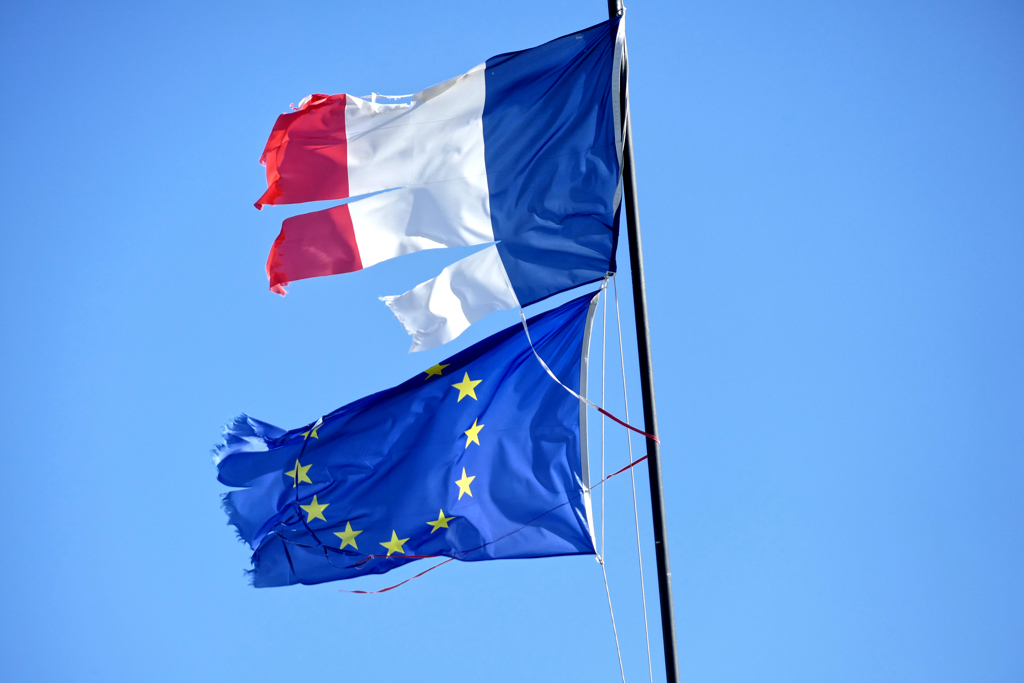
However, landmarks and museums usually also have introductions in English. Still, don’t expect to get very far without halfway decent French. Hence, if you don’t speak the language, you should download a good translation app. Of course, it’s also nice to learn common polite phrases that you can pick up on babbel or Lingohut, for example.
Extra Tip:
Make sure to start every conversation with Bonjour. Every single one without exception. No excusez-moi, no, first a bonjour, then the apology, then your question.
Connection and Communication
One of the perks of Martinique being actually part of Europe is the connectivity. Since June 2017, no roaming charges have applied within the EU with a European mobile phone contract. Therefore, roaming is available just like in the so-called Métropole or Hexagone, hence, in France.
If you don’t have a European phone contract, you can still connect to the internet without any issue at many places like eateries, cafés, and, of course, hotels. If you insist on being online 24/7, you can get a SIM card, obviously. There are prepaid SIM cards by many companies. The cheapest one is distributed by Orange France, other brands are for instance Digicel and RED Caraïbe. However, keep in mind that some companies might also charge an activation fee.
In France, they use plug types C and E. Their voltage is 230 V and the frequency 50 Hz. Whereby, nowadays, all these chargers have integrated adapters so that the voltage and frequency shouldn’t really matter.
By the way, you’ll find this information and many more comprehensive travel tips in my post World’s Most Complete Travel Information – an indispensable globetrotter-classic.
Map
On this map, you can see where to find all the places you shouldn’t miss on your visit to Martinique. Clicking on the slider symbol at the top left or the full-screen icon at the top right will display the whole map. Then, to switch between the individual areas, just open the legend at the left upper corner and you can hide or unhide the respective layer as you wish. This way, the map will show only the section you really need and be more clear.
Pinnable Pictures
If you choose to pin this post for later, please use one of these pictures:



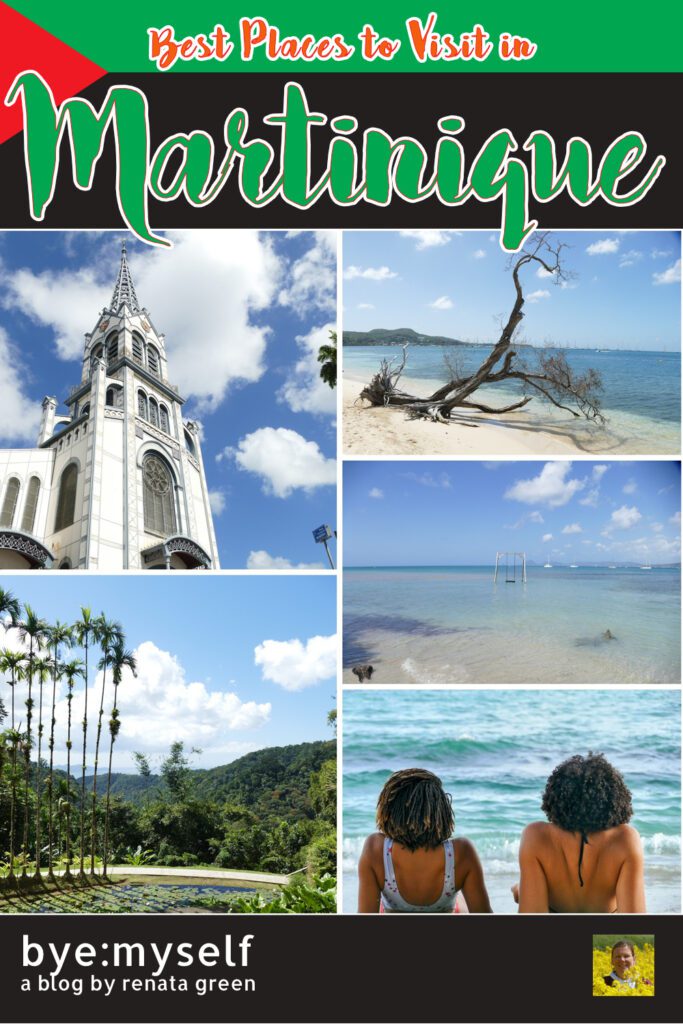
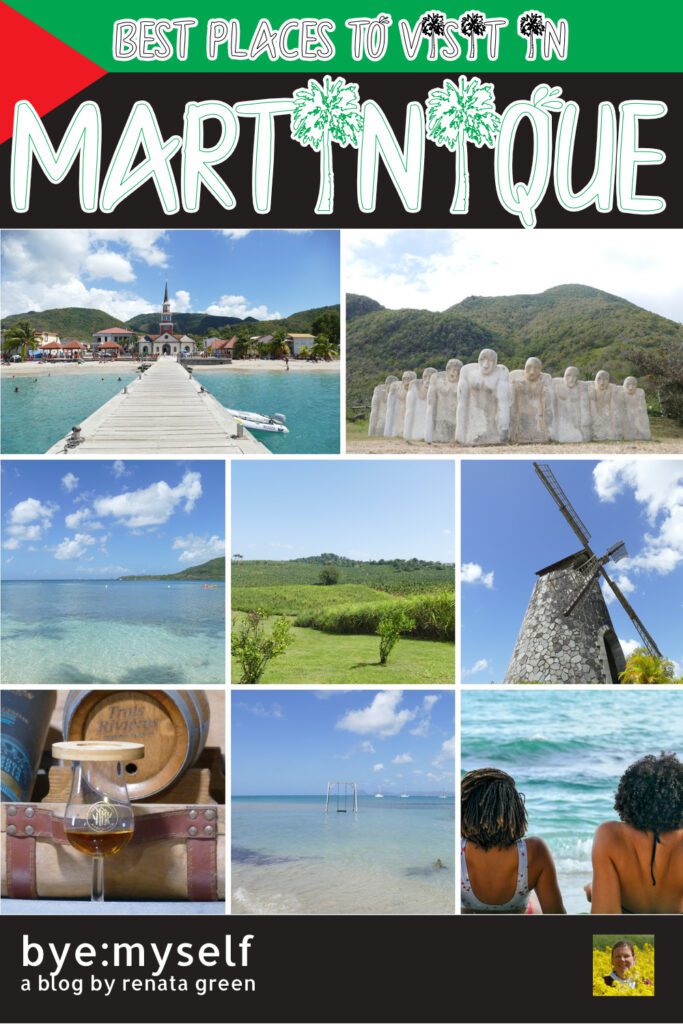
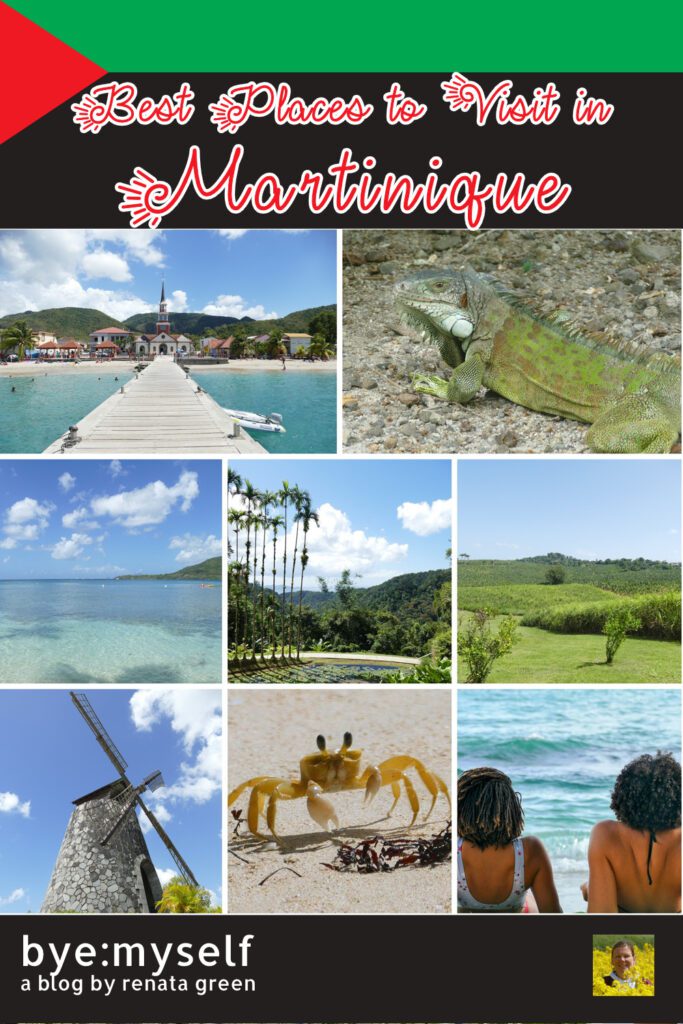
Note: I’ve thoroughly completed, edited, and updated this post in May 2025.
Did You Enjoy This Post? Then You Might Like Also These:
The Best Street Art in MARTINIQUE
Guide to TRINIDAD – Cuba’s Colonial Fantasy
Murals in CURACAO: The Best Street Art Projects in Willemstad
Two Days in CARTAGENA
MAGNIFICENT MARTINIQUE: Ten Places Not to Miss on Your Visit (even when exploring by public bus)
Guide to SANTA CLARA – Reliving Cuba ‘s History
Guide to CAMAGUEY – Cuba’s Modest Beauty
One Week in BONAIRE: The Best Activities Beyond Diving
* This is an affiliate link. If you book through this page, not only do you get the best deal. I also get a small commission that helps me run this blog. Thank you so much for supporting me!



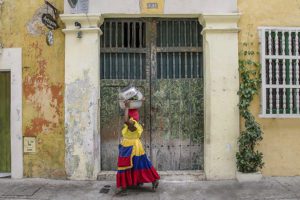
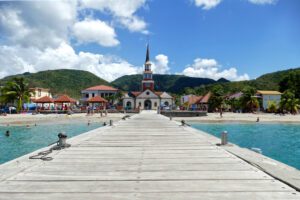
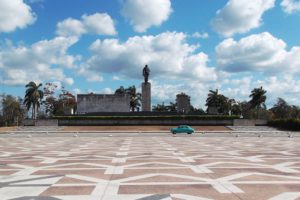

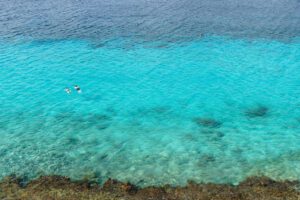
What’s up, I would like to subscribe for this blog to get hottest updates, so where can i do it?
Hi Virgilio, Thanx for your interest. There is a form in the sidebar. After you fill that out, you’ll get my monthly Calendar Sheet. Cheers!